Music is the universal language
“Glory to God in the highest heaven, and on earth peace to those on whom his favor rests.” - Luke 2:14
Premier Guitar
¡Viva la Vihuela!
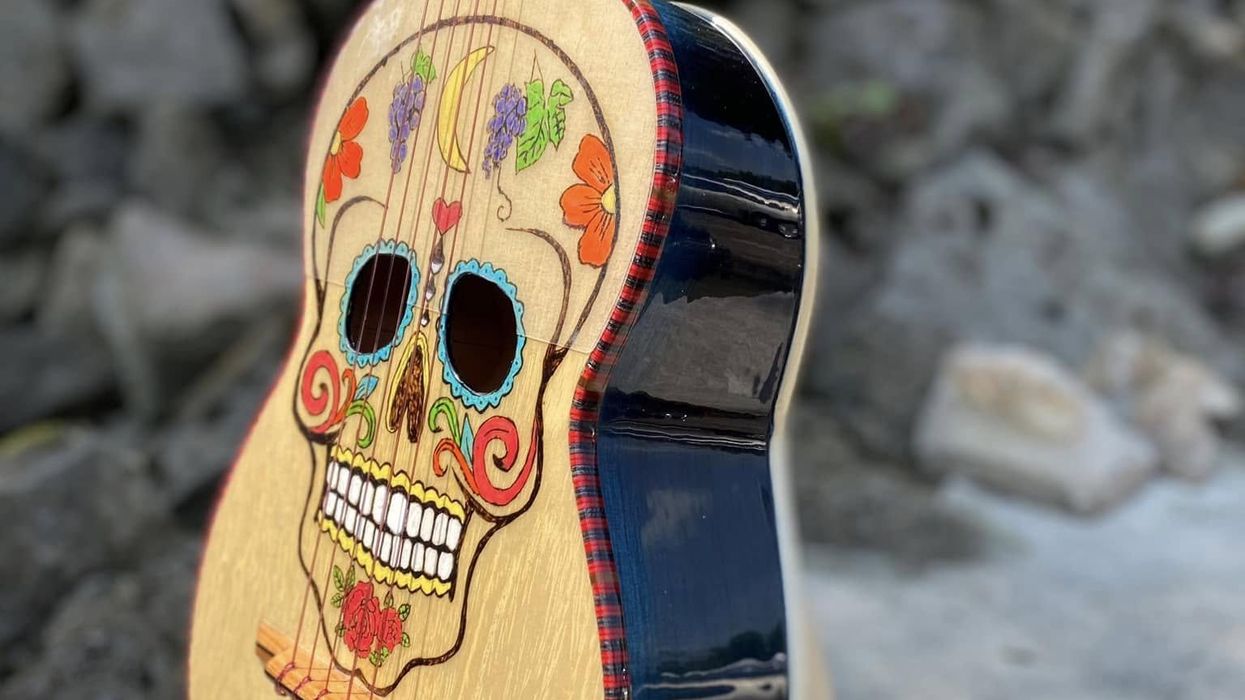
Get to know the 5-string heartbeat of mariachi ensembles.
For any guitarist captivated by vibrant rhythm and unique sonic textures, the Mexican vihuela is an instrument that demands attention. Its instantly recognizable, bright, percussive strumming is the heartbeat of mariachi music, contributing an undeniable energy to the ensemble. But the vihuela’s story stretches far beyond the iconic mariachi sound we know today, rooted in European ancestry yet blossoming into a distinctly Mexican voice—one every serious string player should explore.
The vihuela’s lineage traces back to the Spanish vihuela de mano, a sophisticated plucked string instrument that thrived in the 15th and 16th centuries. This European ancestor, often boasting six courses of strings and a familiar figure-eight body shape, made its way to the Americas with the Spanish conquistadors. While the Spanish vihuela eventually faded in Europe, it found fertile ground in the New World, particularly in Mexico, where it began its remarkable transformation.
On Mexican soil, its size generally became more compact, and the string count typically settled at five, tuned in re-entrant courses, which is another way of saying the strings aren’t strictly pitched from low to high. The vihuela’s tuning is much like the first five strings of a guitar, but with the lower courses tuned higher. Most notably, the back of the instrument transformed into its characteristic convex shape, affectionately known as la jaroba. This unique curvature isn’t just for aesthetics; it’s a key contributor to the vihuela’s incredibly bright and resonant tone, allowing it to project over other instruments. While the exact reasons for this design shift are debated among historians, it undeniably gave the Mexican vihuela its unique sonic and visual identity—a true testament to organic instrument development.“The Mexican vihuela remains an indispensable part of mariachi music, its lively strumming instantly evoking the spirit of Mexico.”
By the 19th century, the vihuela was deeply integrated into various forms of Mexican folk music, not solely confined to what we now recognize as mariachi. Historical accounts show it played in diverse regional styles alongside instruments like harps and violins. Its smaller size made it portable and perfectly suited for impromptu sessions and communal music-making—traits that resonate with any gigging guitarist.
The vihuela’s ascendance to international recognition, however, came with the rise of modern mariachi in the late 19th and early 20th centuries. As mariachi ensembles solidified their instrumentation, the vihuela became a cornerstone of the armonía (rhythm) section. Its higher register and percussive attack cut through the ensemble, providing rhythmic and harmonic accompaniment with distinctive strumming patterns, complementing the deeper tones of the guitarrón and the melodic lines of the trumpets and violins.
For guitarists, the vihuela’s playing technique is where things get truly interesting. Often played with a powerful strum that uses all the fingernails—a technique called the mánico—it generates a driving and energetic pulse that’s both rhythmic and harmonic. While understanding chord voicings is crucial, the articulation of the mánico is paramount, providing the foundational groove and propelling the music forward. This rhythmic sophistication is so integral that the specific mánico strum pattern is often how experienced listeners identify the style of music a mariachi band is performing.
It’s a common misphrasing to say, “They are playing mariachi music,” when in fact, mariachi is the ensemble, performing various musical styles within its framework. Just as a symphony might play a sonata, rondo, or minuet, a mariachi ensemble performs styles including rancheras, huapangos, waltzes, sones, corridos, boleros, and polkas, to name a few. And the vihuela’s strumming, or mánico, is often the identifying factor.
Today, the Mexican vihuela remains an indispensable part of mariachi music, its lively strumming instantly evoking the spirit of Mexico. It’s a living legacy, a testament to the blend of cultural heritage and musical innovation. In honor of Hispanic Heritage Month and the celebration of Día de los Muertos, I’ve included photos of a custom Mexican vihuela I recently built for Olivia Nuñez, an artist performing with Herencia Mariachi Academy in Corona, CA. It features symbols representing cherished memories of her family members who have passed away—a perfect representation of not only the music it shares, but also the profound importance of Mexican culture and family it embodies.
The vihuela’s journey is a captivating one for any string player. It stands as a powerful example of how instruments evolve and adapt, ultimately finding their own distinct voice within a new cultural landscape. The next time you hear the spirited strum of a vihuela, you’ll appreciate its rich history—a story etched in wood and resonating through generations of captivating Mexican music.
Les Paul Is Everywhere | 100 Guitarists Podcast
When you think about the most name-checked guitarist of all time, who do you think of? Hendrix? EVH? Good guesses, but we think it’s gotta be Waukesha, Wisconsin’s own Les Paul. Though his name lies atop one of the most popular guitar models of all time, there’s so much more to Les. His inventions span modern recording history, and with his music—whether with then-wife Mary Ford, solo, with Chet Atkins—he left a mark across genres. And though neither host owns a Les Paul, we’ve both shared space with The Log.
Thanks to Our Sponsor, Gibson!

Fortin Releases the Kali Pre-Amp/Distortion Pedal
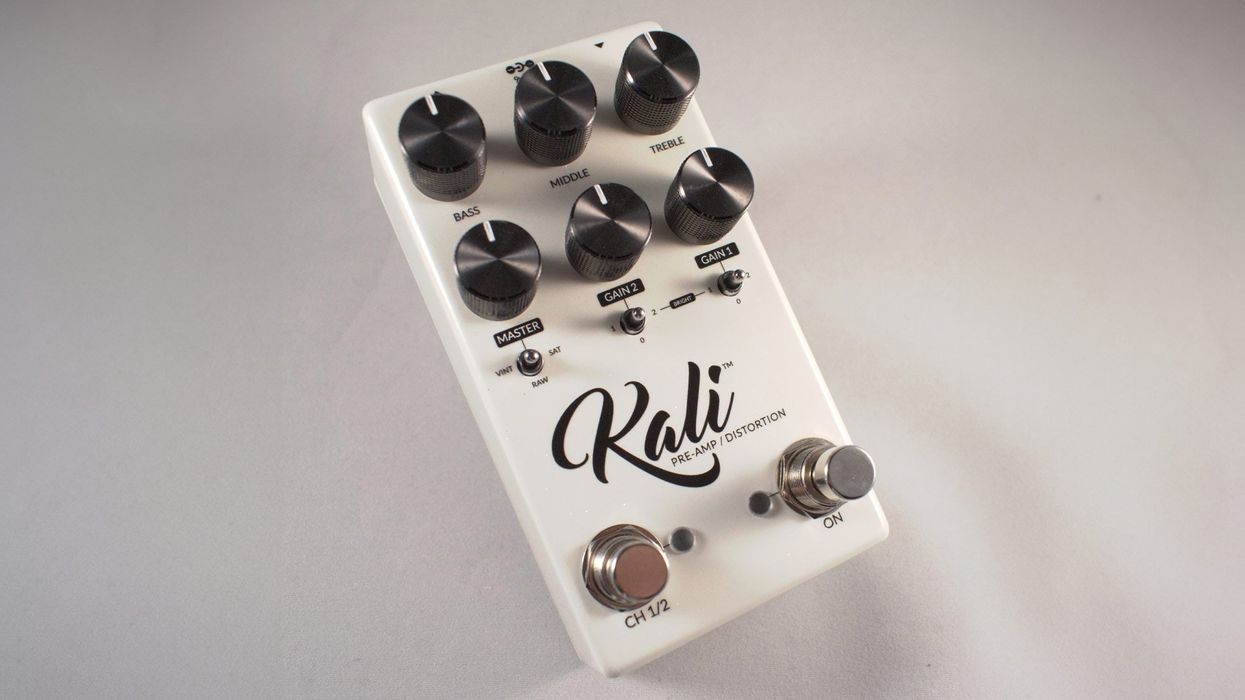
Fortin Amplification has unveiled the Kali pre-amp / distortion pedal, designed to deliver the legendary, brutal tone of the iconic Fortin Cali amplifier.
Fortin Kali Preamp/Distortion pedal
This new pre-amp/distortion pedal allows players to inject the modern rock / metal Cali sound directly into their own rig.
Meticulously crafted by renowned gain specialist Mike Fortin, the Kali pedal has been fine-tuned by Fortin to recreate the amp that came before it. Whether you’re in the studio or on stage, this pedal will provide the precision, power, and clarity that distinguished the original amp.
Key features of the Kali pedal include:
- Active 3-Band EQ: Offering total tonal control to shape your sound
- 3 voicings – Vintage, Raw and Saturated
- Each gain control has a three-way bright switch to provide unlimited tonal options
- Dual Channel Footswitching: Two footswitchable channels for ultimate flexibility
Like the Cali amplifier it is inspired by, the Kali pedal is engineered to deliver the most versatile, most powerful modded tones possible. For guitarists seeking to have complete control of their dirt, this pedal provides the legendary Fortin tone.
Fortin’s Kali pre-amp / distortion pedal carries a street price of $299.00 (USD). For more information visit fortinamps.com.
What Are Your Tubes Really Doing?
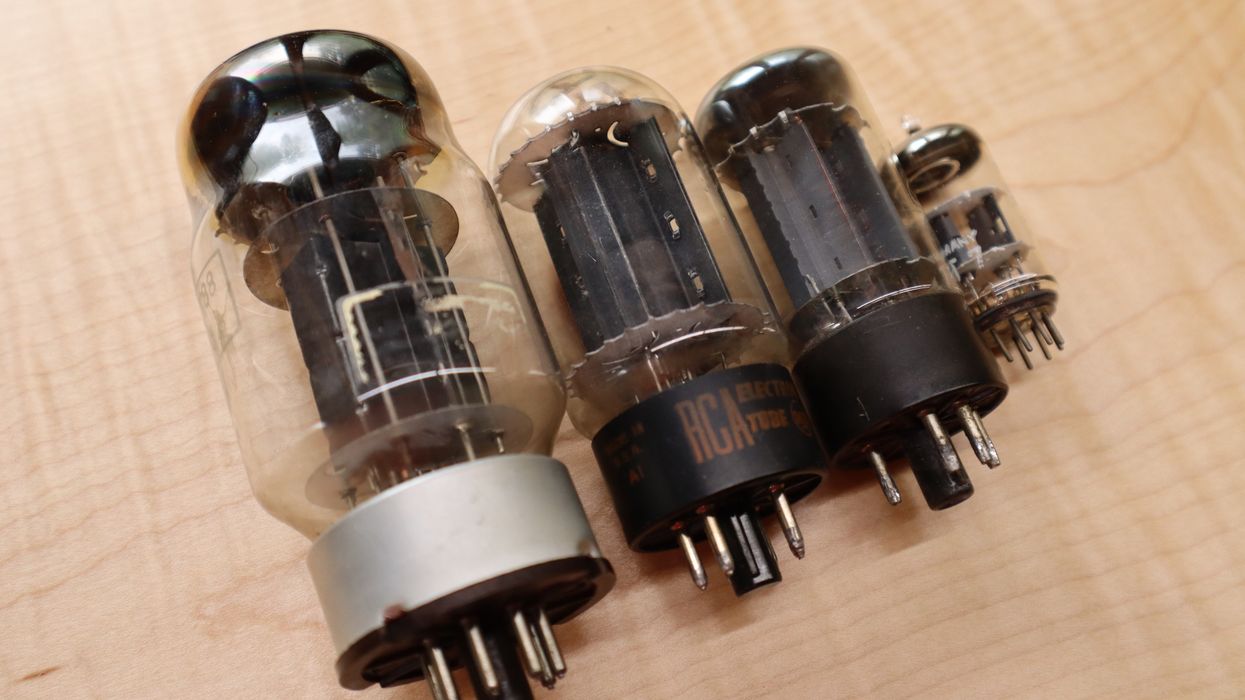
If you’ve never worked on a tube amp, it can be hard to find your way into understanding how they work. Somehow, we create a tiny signal by making metal strings on our guitars oscillate over a magnet wrapped with a coil of wire, and our amp takes that electrical signal and gets it to drive a speaker. (And driving the speaker is basically the opposite of how the signal started: It is a coil of wire moving within a magnet, which drives a speaker cone that moves air.) I’d like to simplify some of the processes that go on in our amps, so even if you’re not an expert, you’ll have some idea of what’s going on.
Let’s look at how tubes work and the role they play in turning our quiet, tiny guitar signals into sound. There are various types of vacuum tubes, but in the guitar amp world, three types are most common: rectifier tubes, preamp tubes, and power amp tubes.
Let’s start with rectifier tubes. As part of an amp’s power supply—the part of the amplifier circuit that makes the voltages the rest of the circuit needs to operate—rectifier tubes help convert, or “rectify,” the AC (alternating current) from the wall into DC (direct current). The amp’s power transformer only runs on AC, so it’s up to the rectifier tube to create DC, which is needed by the other tubes. (The filter capacitors are also part of the power supply, and these are needed to make proper DC from rectified AC, as well as a “choke” transformer.) The tubes that we use in this part of our amp are specialty tubes designed to do this one particular task and are not interchangeable with preamp and power amp tubes.
“The small guitar signal creates electrical movement on the screen of the tube, which causes movement on the plate, which gets significantly amplified due to its high-voltage potential.”
The preamp section’s job is to take the delicate signal from the guitar and amplify it to a level that can drive the output section. This is done in stages because of how small the guitar signal is, which is why we have many 12AX7-type tubes in our amps. Here’s how preamp tubes function:
Typically, V1 (valve 1—this is not a specific part on a schematic in this article but refers to the first tube the guitar signal encounters) will take that delicate guitar signal and amplify it by about 100 times before we do anything with it in the amp. This process repeats in the other preamp tube positions as well. How does a tube make a signal 100 times bigger? The V1 tube has about 300V DC on its plate (and a few volts on the cathode, but I don’t want to get too technical here and explain that—let’s just say that’s part of the operation of the tube). The small guitar signal creates electrical movement on the screen of the tube, which causes movement on the plate, which gets significantly amplified due to its high-voltage potential.
Because these are still small signals, the tubes are small. A 12AX7-type tube has two sections. In this case, V1 can also be used as a second gain stage or the first stage for another channel input of the amp.
Power tubes are bigger. There’s only a single stage inside the glass. Why? Because they do more work. They are the horsepower of the amplifier. They need to drive the output transformer, which pushes that speaker cone to move air. The overall function is the same but with a higher potential. In the power tube’s case, it’s usually 400–500V DC. More voltage means more power available. When we create electrical response on the power tubes with our signal, we get that analog response on the plates. Those plates are connected to an output transformer. The output transformer does what its name states by transforming the signal on the primary side (the power tube side) to what is on the secondary side, which is the speaker.
The power tubes need that high-voltage DC to operate, but a speaker only wants 10–30V AC to rock our world. The output transformer separates the AC guitar signal from the DC power supply. Again, there’s a bit more to this, but the power tubes are coupled to the speaker, driving that speaker and doing the hard work of moving air.
You might not be ready to go repair your amp, but hopefully, you now have a better idea of how your tubes work.
Luck and Strange: Bassist Guy Pratt’s Career in Rock
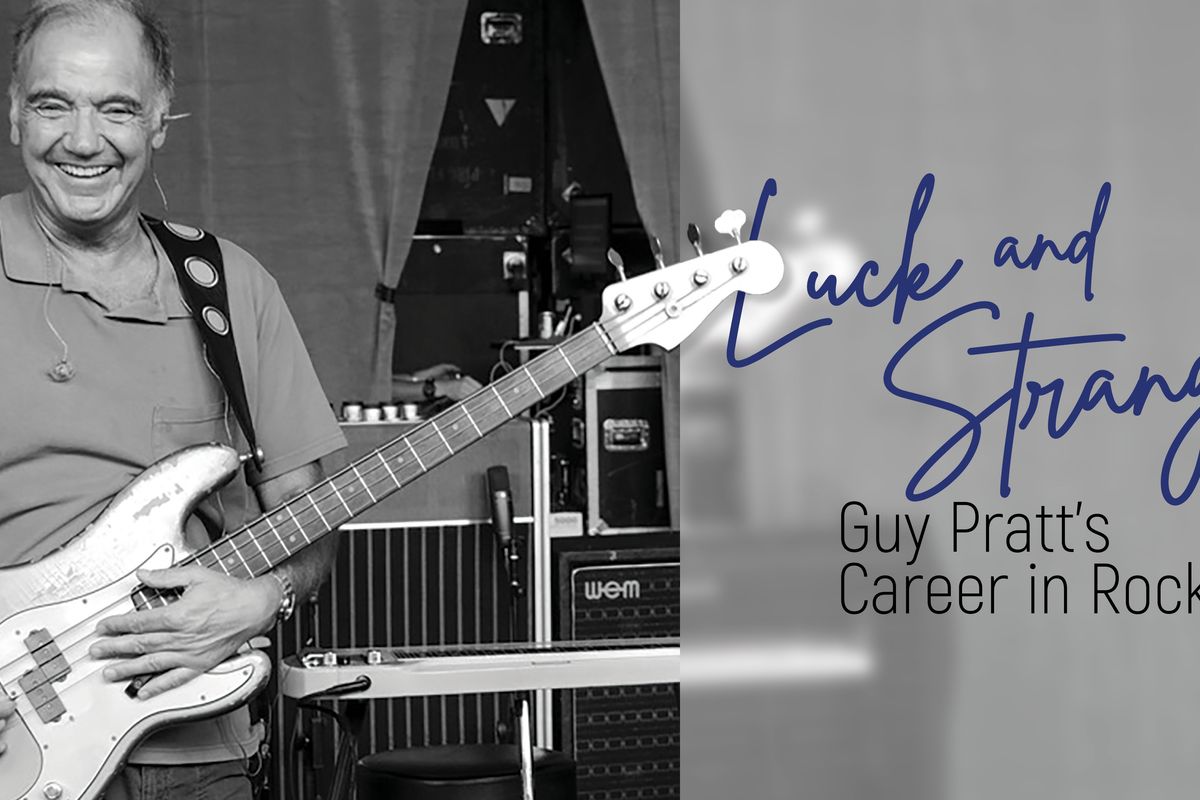
Over four decades, the Grammy-winning English bassist has held down the bottom for Roxy Music, Bryan Ferry, Pink Floyd, and David Gilmour. He’s recorded with everyone from Pete Townshend to Madonna and Michael Jackson, and he’s also a popular podcaster and stand-up comic. Whatever’s next, he’s ready.
If Guy Pratt’s name doesn’t resonate with you, his bass playing certainly has. He’s held the low end down for Pink Floyd and David Gilmour since 1987’s Momentary Lapse of Reason tour, and elsewhere in the Floydian universe he’s a member of Nick Mason’s Saucerful of Secrets, which specializes in the legendary band’s early music.
But wait, as the old huckster’s line goes, there’s more. Lots more. He’s also a longtime member of Roxy Music and Bryan Ferry’s band, and has toured with the Smiths. As part of the new wave band Icehouse in the early ’80s, he scored on the European and Australian charts and opened for David Bowie, and then springboarded into a series of higher profile gigs. In the studio, those have included sessions for recordings by Gary Moore, Michael Jackson (“Earth Song”), Tears for Fears, Echo & the Bunnymen, Iggy Pop, Tom Jones, Whitesnake, the Orb, Debbie Harry, Robbie Robertson, Madonna (“Like a Prayer”), and, in 2022, Pete Townshend. He also shared a Grammy for his playing on “Marooned” from Pink Floyd’s The Division Bell.
And yes, there’s still more. In addition to Pratt’s many TV, film, and theater scores, the amiable London native embarked on a sideline of stand-up comedy beginning in 2005, when he took his one-man-plus-bass show to the Edinburgh Festival Fringe. That show, My Bass and Other Animals, spawned his book, and he’s toured two more original comedy productions since. In his spare time, he started a podcast, Rockontours, with Spandau Ballet’s Gary Kemp, a co-conspirator in the Saucerfull of Secrets band. Their famous guests, spinning tales of the musical life, have included Nick Mason, Bob Geldorf, Phil Manzanera, Trevor Horn, Chris Difford, and Adam Duritz over 213 episodes.
Last year, fortunate concertgoers got a chance to hear Pratt on Gilmour’s 21-concert, four-city tour behind Luck and Strange, an album where Pratt’s playing is woven into the deep currents that support the gorgeous tide of music created by the guitar giant and his hand-picked ensemble in the studio.
There’s an old saying among musicians that if you always want a gig, play bass or drums. Just before his teens, Pratt settled for bass. “I wanted an electric guitar,” he recalls. “I fell in love with electric guitar. Simple as that. I begged my parents, and of course mum said, ‘Oh darling, why don’t you get a nice Spanish guitar?’ ‘Spanish?! I’ll do that at school.’ Rock ’n’ roll was outside the school gates back then; it wasn't where we are now. And it had to be electric. The joke I would say is that actually a toaster would have been closer to what I was after than a Spanish guitar. So I asked for a bass. My mum and dad clubbed together and got me—because my birthday’s near Christmas—a bass guitar for Christmas and birthday. It was really weird … huge and kind of confusing, and I didn’t have an amp. But when I went back to school two weeks later, there were three kids who had got electric guitars for Christmas. Of course, if they wanted to be a band, they needed me, so I had my pick.” And so Pratt’s career began.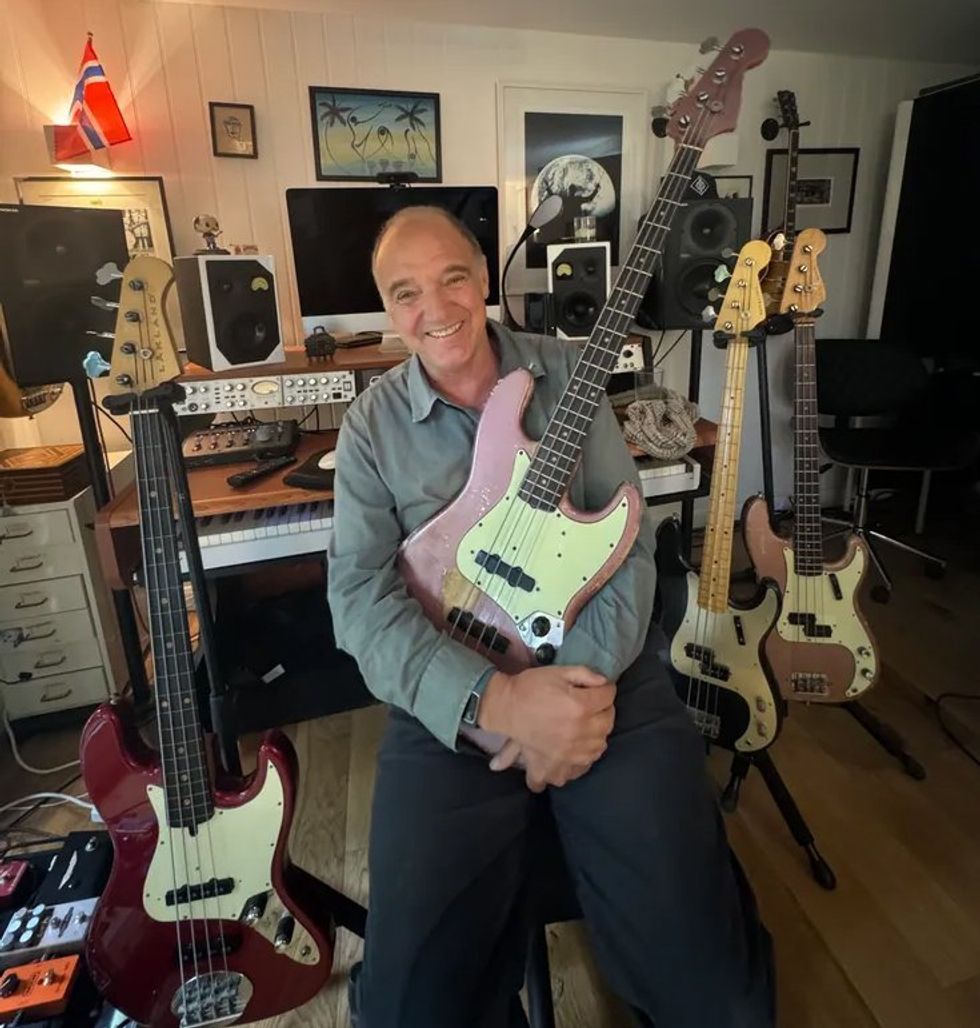
Guy Pratt’s Gear
Basses
- 1964 Fender Jazz Bass (named “Betsy”)
- 1960 Fender Jazz Bass (stack knob; present from David Gilmour)
- Nash Guitars T-style (w/ P- and J-bass pickups)
- Nash Guitars P-style
- Spector NS-2
- Lakland fretless bass
- Stratus 5-string
- Rickenbacker 4001V63 (w/ Nick Mason‘s Saucerful of Secrets)
- Rickenbacker 4003 (w/ Nick Mason‘s Saucerful of Secrets)
Amps
- Ashdown Guy Pratt Signature Interstellar-600
- Ashdown CL-10 cabs
Effects
- TC Electronic Hall of Fame
- Boss ODB-3 Bass Overdrive
- TC Electronic Subnup
- Ashdown Bass Graphic EQ
- Two Boss GEB-7 Bass Equalizers
- Boss DC-2w Dimension C
- Peterson Strobostomp HD
- Demeter Opto Compulator
- Custom Pedal Boards router
- Lehle volume pedal
- Ashdown footswitch
- Dunlop JCT95 Justin Chancellor Cry Baby Wah
- Dunlop volume pedal
- Boss Digital Delay DD-500
- Foxgear Echosex Baby
- Boss OC-Octave
- MXR Phase 90
- Origin Effects Cali76 bass compressor
- The Gig Rig QuarterMaster QMX-10
Strings & Picks
- Elites Stadium Series Roundwounds (.040–.100)
- Dunlop Tortex Triangle .88 mm (for older Pink Floyd songs)
I’ve been listening to your playing since the ’80s, when you started working with Bryan Ferry and with David Gilmour and Pink Floyd. Your tone has evolved over the decades, from what I would describe as a pointier sound.
Yeah, it was all front end. I was playing a Steinberger and it was bridge pickup. There was a lot of slapping. In the ’80s, bass was almost doing a different job because with a lot stuff I did there was a keyboard bass as well. Like when I used to work with [producer, drummer, and an original member of Duran Duran and the Lilac Time] Stephen Duffy, often I would go into the studio and I went on after the vocal. And my job was to kind of put stuff in the gaps, more like a horn part than bass.
It was the first drum-machine generation, and suddenly LinnDrums were everywhere. The bass wasn’t necessarily doing the job it had to do. You weren’t in the room with the drummer laying the thing down. With the birth of hip-hop and the new romantics and then bands like Simple Minds, everyone was coming from a quite funky perspective. There was a lot of stuff happening with technology and the bass responded really well to technology, with the Steinberger and various effects and amps. It felt like guitar was really taking a back seat at that time, too.
I mean, I was an asshole. Twenty-one-year-olds are assholes, aren’t they? So I guess the way I would look at it is I’m now a bass player. And maybe I needed the 40 years to become one. [laughs]
At what point do you feel like you made that transition?
I think it started on the ’94 Floyd tour. That’s when I suddenly started thinking, “Wait a minute, what are you doing here? You should be playing a Precision with a pick.” And then I kept at it. By 2006, the [David Gilmour] On an Island tour … I would say since then I’ve been a grown-up, if you will.“There’s no need for a sixteenth note on the bass anywhere in this music, ever.”
You’ve mentioned retooling your gear specifically to address that sort of deeper, more grown-up tone. And you’ve spoken about a particular instrument that you created—part Jazz Bass and part Hofner.
Bill Nash, who’s a friend and who makes the most beautiful guitars and basses, gave me a Telecaster bass. And it had one of those open [uncovered] pickups on it, but it also had a Jazz pickup. It’s got my Luck and Strange sticker on it, because it’s my Luck and Strange bass, and a stack knob. And the thing was, I was trying to think where to use it. On “The Piper’s Call,” David got ahold of the violin bass and noodled around, and it’s gorgeous stuff. I played a big, rounded Fender part that David told me to. Of course, when it came to rehearsing for the live shows, David said, “Well, obviously you’re doing both parts.” And I thought, “How the hell am I doing that?” Because there’s the Fender part and this nice little “do-do-do” going on top. I tried playing it with a violin bass. That just didn't work. It’s too small, just too insubstantial for me to hold. And it didn’t work on the Fender. So then I thought, “What would David do?” Because he’s really good at coming up with A-team-type solutions for things, like re-tuning his lap steel so he’s got a major and a minor chord. I was trying to think of a version of that, and I said, “Ah-ha! What if I take this Nash bass, and on the top strings, the D and the G, put on flatwounds, and then get a bit of foam and stick it under just the top two strings.”
What I always find interesting when rehearsing with David is what he remembers from bass parts. “You need to play that”—that sort of thing. A lot of the music is so slow and so big and there’s so much space in it. Very often it’s actually the length of the notes rather than how many notes you’re playing that matters more. With David, and this is something I get with the wisdom of years, every note does count. It’s quite funny when I think back to what I used to play in jams with him, like when we did a week of the Division Bell rehearsals. I was still stuck in that thing of playing sixteenth-note parts. It’s just like, “Why?” There’s no need for a sixteenth note on the bass anywhere in this music, ever.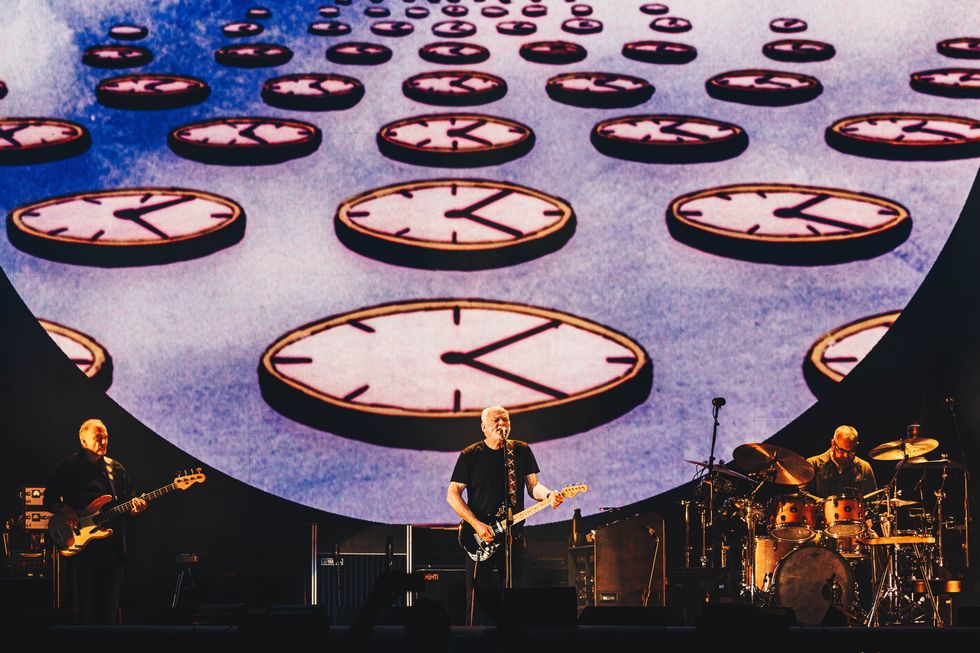
Your career started, essentially, playing in new wave bands and on sessions, including Madonna’s “Like a Prayer.” But now you’re best known for your work with Pink Floyd, Bryan Ferry and Roxy Music, David Gilmour … more atmospheric music. What was that transition like for you?
There’s a quote: “As you live your life, it seems this absolutely chaotic, random set of events. And then when you get towards the end and you look back, it’s like the most beautifully plotted novel.” When I was playing with Icehouse, [frontman] Iva Davies wore his influences on his sleeve: Simple Minds, Bowie, Ferry, which was great stuff. I loved it. So I became versed in that style of playing. When we were making the second album, we got Rhett Davis, who was Roxy Music’s producer, for one of two reasons. Iva sang so much like Bryan Ferry that it was like, “If he’s gonna do Bryan, let’s do this properly.” Or Davis’ gonna go, “Come off it! Be yourself.” Anyway, it was fantastic working with him and we really got on. So it came to pass that I auditioned for Bryan and I got the gig. Even though I’d already worked with Robert Palmer, who was a huge, huge hero, this was different. Working for Bryan was crossing the Rubicon—as big as Bowie, an absolute icon in my head. So anything after that, Pink Floyd, nothing was gonna get bigger anymore. It was like, “This is Bryan fucking Ferry, you know?” Bryan is still my longest working relationship. I’ve been working with Bryan for 40 years.
“Something that I really noticed on the tour is it feels like David now owns his past. He’s not owned by it.”
Focusing on David, who you’ve been working with for 38 years, did that relationship start after he played on Bryan Ferry’s Boys and Girls sessions?
The first thing was, I was playing for Dream Academy and David had produced them. He needed a support band for this one show in Birmingham. It’s quite funny because Nick Laird-Clowes, the main guy from Dream Academy, is this fantastic, enthusiastic character. And he said, “David’s heard your playing. He thinks you’re amazing. He can’t wait to meet you”—which of course was just bollocks. So we get up there in Birmingham. I’m terrified. And he said, “David’s just dying to meet you.” And I went in and just stood in his dressing room and it was awful. We both stood there with nothing to say until one of us had to walk away. David, being the ranking officer, got to be the one who walked away. And that was the end of it. But I got to spend a bit of time with him with Bryan, which sort of loosened things up a bit. And I started just seeing him out and about. I think I was just getting invited to better parties. [laughs]
So, I went on holiday to Thailand and I came back and there’s all these messages from David. The first one saying hi, he was doing an Amnesty International concert, the Secret Policeman’s Ball, and he wanted me to play with him and Kate Bush. And there’s another message and another message. “Hi Guy, just wondered, it’s next week you know.” And then, of course, he had to get someone else. I’m like, “My god, that was my one shot.”
A while later, David, Rick [Floyd keyboardist Richard Wright], and Nick were saying they were doing a new Pink Floyd album, and I didn’t think any more about it until I got a phone call from L.A., and it’s David going, “Hi. We’re putting Pink Floyd back together.” He said, the tour was gonna be a year, and would I be interested and available? So I went, “Yes!” And he said, “Oh, not working much, then?” And that started our relationship of him ribbing me and me constantly falling for it. That’s been the hallmark of our relationship for the last 38 years.David’s latest solo album, Luck and Strange, seems perhaps more organic than most of the Pink Floyd albums he’s helmed and his earlier solo work. After all these years working with him, you’re in a good position to comment on that. Is there something different that you find within it?
I know what you mean. There’s definitely been something different about this album, about the way it’s been received, about the tour. It was hugely successful in a way that some people’s solo records could only dream of. On An Island is where it started. There are quite a few people now who will point to the song “On An Island”’s solo as on a par with “Comfortably Numb.” But there’s something about this one, a sound. And a lot of that’s to do with Charlie Andrew and Matt Glasbey's engineering. It feels of a piece. And something that I really noticed on the tour is it feels like David now owns his past. He’s not owned by it. And for me, if you look at the set list, well over half is songs I played on. It’s always been quite piecemeal with David’s other records. I’ve gone in for a couple of days here and there, but David’s played quite a lot of bass himself. He’s brilliant.
With David, there is always this thing where suddenly he’s puttering about, then puttering about a bit more, and then suddenly “bam,” we’re in gear—there’s an album. We did a whole week in British Grove Studios with Steve Gadd, which was amazing. His playing wounds you, gets you in the chest. It’s so light and so potent. It’s just gorgeous. Why I think he was such a great call is that, in all my years with all those elite drummers, Steve is the closest to Nick.
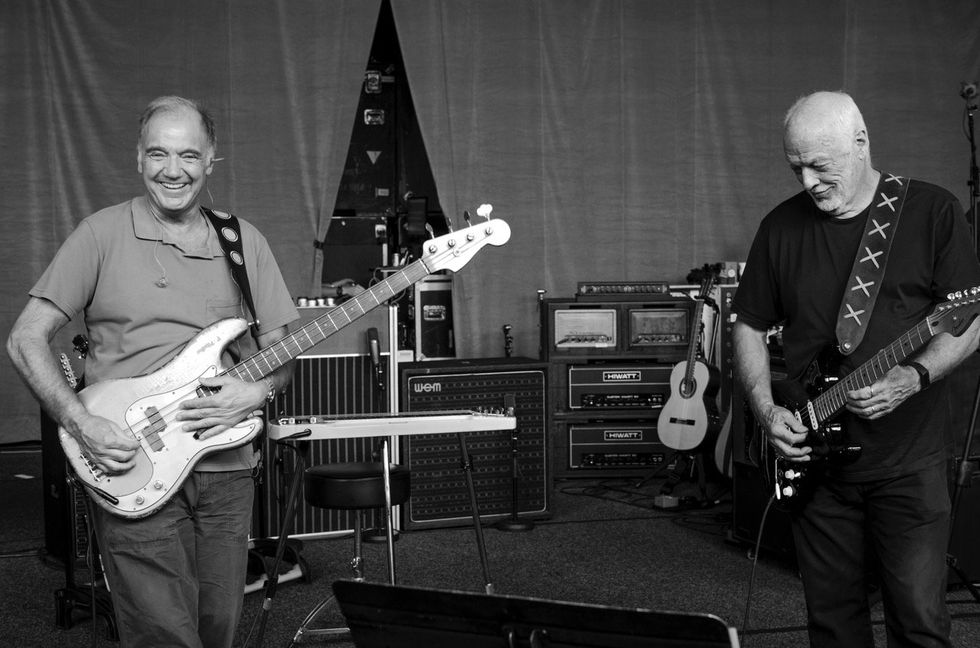
I think Nick is a vastly underappreciated drummer. I love his playing. It’s so conversational.
That’s a great way of putting it. Yes, he absolutely was underappreciated, in the same way, if you remember years ago, that David was actually a somewhat underrated guitarist. And you know, I’ve noticed that with all the top drummers I talk to now, everyone’s like, “Nick Mason, man!” It seems like he can take his playing anywhere he wants to and feel utterly relaxed at the same time. And what’s been amazing with the Saucers, because we’re doing all that early stuff, is it’s so crazy, manic. I get worried for him, you know. “Should someone have a heart monitor on him or something?” But that stuff doesn’t seem to bother him at all. It’s fantastic.
I need to ask, what was it like playing onstage in Pompeii? A beautiful setting; what an extraordinary experience.
At the risk of sounding unbearably smug. I’m one of the small group of people that played Pompeii twice. With David, we were on a stage at the end of the amphitheater. It was so small, we just had the screen, there was no sides, there was no roof; it was mad. There was only 1,800 people, so it was like a club gig. It was fantastic. And with the Saucers, we played at the Teatro, which is the theater, which is really small but lovely, in a different part of the complex, but it’s still Pompeii. But we did it in the middle of an absolutely horrendous heatwave. So it was nearly 40 degrees [104 Fahrenheit] and we couldn’t sound check. The poor crew were wilting and we basically just had to sit on the bus and then went in through the audience, did the show, and left. Whereas with David, we had Mary Beard, the great historian with us. We were there for four days.
“At the risk of sounding unbearably smug, I’m one of the small group of people that have played Pompeii twice.”
You’ve done extensive film and television work. How did you get into that?
I love working on film. I used to work with Michael Kamen a lot. I love working to picture. I also love that it is a great way of writing music and not having to finish it. Usually, you come up with a great piece of music and, okay, well now I need a verse, now I need a bridge. Whereas with a film score, it’s like this character needs something. That’s it. Then you move on. TV music is like the demo version of film music. No one expects a real orchestra, so you’re kind of going, if this was a film, the music would be doing this. Of course, now everyone’s got massive screens and 5.1, so the stakes are higher.
That came about through me hanging about at the Groucho Club, which is this big media arts club in London, and just telling people I wanted to do film music. The first thing I did was a documentary … on the Roswell autopsy. That was completely fake, but it was perfect. This was was mid-’90s, so it was the whole electronica and ambient house, chill, Orb scene. So perfect for that sort of film. But then I got this fantastic gig, which I’m still really proud of, which is this TV series, Spaced, with the director Edgar Wright, with Simon Pegg and Nick Frost starring in it. Edgar, if you know from his films, is such a film nerd, so literally everything is a reference. It was brilliant. I had to do Kubrick. There’s a bit of what looks like a zombie movie, so I had to kind of write a John Carpenter score.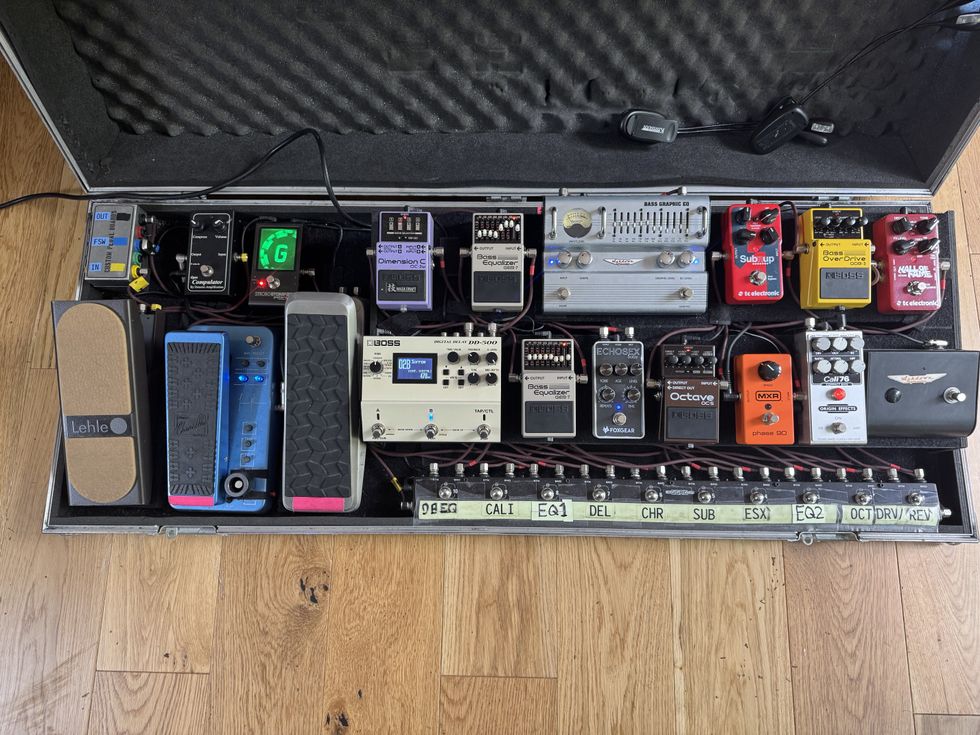
You’re also a podcaster, and your Rockonteurs, with Gary Kemp, is very entertaining, with its “behind the music” approach
The podcast came about literally from the first Saucer Full of Secrets tour. We had this tour bus and this is long enough ago that the bus actually had a DVD player. And I brought a box set of The Old Grey Whistle Test, which is the legendary 1970s English music TV show. We used to watch it on the bus, and it was just brilliant. Everyone had an opinion about every act that was on, or a story. Of course, half the time Nick knew them and he’d have some great stories and we’d be talking about it, and someone said, “Man, we should do a podcast.”
We didn’t know it was gonna fly at all. We had this address book, we just asked a few mates to come and do it. And it just became a thing, you know, and it’s really nice because no matter how well I know the artists, we always get something I’ve never heard. We had a couple of scoops. My favorite got on the front page of The Times and The Guardian, when Whispering Bob Harris, who used to present The Old Grey Whistle Test, told us that Nixon asked Elvis to spy on John Lennon.“All musicians have really funny stories because it’s a kind of preposterous life we lead.”
You also do a one man bass-and-jokes comedy shows?
All musicians have really funny stories because it’s a kind of preposterous life we lead. So I started telling them, with my bass in hand, and it did really well. So then I had to write a book [My Bass and Other Animals]. I went around the world with it, been to Australia four times.
It’s something I really like, because I knew I was never going to do a solo musical thing. I really love the job of the bass. I mean, I’m very happy being the center of attention at a table or whatever. But in a musical set, I really love that thing of playing the instrument that just makes everyone else work. But there’s a syndrome I call “sideman bitterness” that I’ve seen happen a lot. When people start getting to their 50s or whatever, it’s like, “Where’s my shit?” And so I thought, “Well, I need to do something on my own to avoid that.”
Another thing is that when you get up on stage with Bryan Ferry and play “Love Is the Drug,” you’ve got a pretty good idea of how it’s going to go. With David Gilmour, when you play “Wish You Were Here,” you’ve got a pretty good idea of it. What I love with stand-up is that I get up there and people don’t really know what I’m gonna do. They don’t really know what they’ve come to see. I’m not entirely sure about it. It’s completely fresh, in the moment. And I think that’s something that might have made me a better bass player, in a way. Because now I’ve had it all on my shoulders, so it’s really nice to go back and just be the guy playing bass.YouTube It
David Gilmour is Guy Pratt and Gary Kemp’s guest on this episode of the Rockonteurs podcast.
Think Like a Drummer
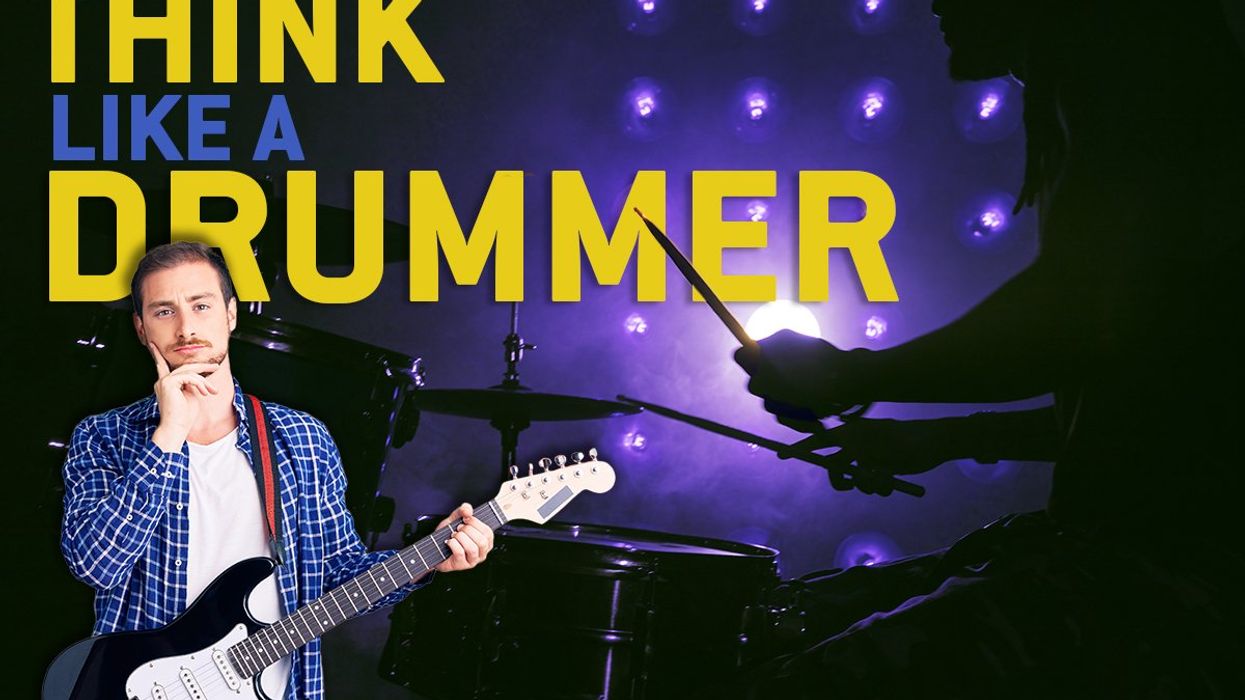
I recently published my book Creative Rhythms for Melodic Instruments or Think Like a Drummer, and I’m delighted to say it has been met with great enthusiasm by players and educators. The premise is simple: Take some of the most iconic drummers—from all genres—and use “in-the-style-of” drum fills as source material for melodic phrases, all in a variety of scale and arpeggio patterns, as well as multiple keys.
In addition to the notation, I also released audio examples in a call-and-response manner, allowing musicians to play along with the melodic phrases, with the isolated drums, or respond to the phrases with their own ideas. (Note: The audio for the book features drums and piano, as the book is available in several versions: guitar tab, bass tab, treble clef, bass clef, Bb instruments, and Eb instruments. Nevertheless, for this lesson I have specifically recorded electric guitar.) I also want to point out that the examples in this lesson are not duplicates from the book, but rather, as the book encourages, creative variations.
Icons of the Drum Kit
As I wrote in my book’s introduction, there are countless phenomenal drummers absent from my examples. I can name at least two dozen more drummers I wish were included (in fact … I’m working on Vol. 2). So let’s not nitpick as to who’s the best drummer, let’s just start playing: In the style of …
Ex. 1
Ringo Starr
It is unnecessary to rehash how underrated Ringo is. Instead, listen to the third verse of “Hello, Goodbye,” “A Day in the Life,” or any of the Live at the BBC recordings. Ringo has style! Ex. 1 is a Ringo-style fill, with lots of space (drummers, it’s okay to rest), and features both descending D Dorian and C major scales. (Remember, D Dorian is just C major starting on D.) Emphasize those rests, people!
Ex. 2
Bill Ward (Black Sabbath)
Of all the drummers in my book, I think Bill Ward’s fills are the most recognizable. Bill has distinct flair and an overlooked swing feel. To honor Black Sabbath in general, Ex. 2 features E minor pentatonic and E harmonic minor, played in descending groups of three. That’s down three notes, back one, and down three from there. Groups of three is a rather cliché move, still, when you add a unique rhythm—as demonstrated here—the pattern takes on new life.
Ex. 3
Neil Peart
What more needs to be written about Peart? Or Rush in general? Nothing. Legends. The end. Ex. 3 is based on one of Peart’s most iconic fills (you’ll guess it.) and uses A Phrygian dominant, in two octaves, in homage to Alex Lifeson’s solo on “YYZ.”
Ex. 4
Richard Bailey
Bailey is arguably the least well-known drummer in my book, but I guarantee, if you love guitar music, you know his playing. Bailey is the drummer on Jeff Beck’s Blow by Blow (and many other albums and singles). Ex. 4 is the first to showcase arpeggios, in this instance, F#7 to Emaj7, implying an F# Mixolydian sound, from the home key of B, emphasizing the V chord. Think “Freeway Jam.” One thing that makes these rhythms unique are the ties from the “and” of 1 to the 2, as well as the tie from the “a” of 2 to the 3. This is tricky!
Ex. 5
Stewart Copeland
One of my favorite things about Copeland is that he rarely played the same thing two nights in a row. I highly recommend listening to live recordings from the 1979–1980 Reggatta de Blanc tour, particularly the breakdown section (after the guitar solo) of “So Lonely.” Consistently brilliant and incomparable. They might have been the best band in the world on that tour. Ex. 5 provides us with a Copeland-esque fill (note that grace note on beat 4) and a C#m pentatonic lick with bends and pull-offs, à la “Message in a Bottle.” If you’ve never paid attention to Andy Summers’ fills in that song, do so. He’s more B.B. King than “King of Pain” on that one.
Ex. 6
Chester Thompson
It’s difficult to know who Thompson is most famous for playing with, Weather Report, Santana, Genesis, or, for my money, Frank Zappa. Thompson’s tenure with Zappa allowed him to truly experiment with rhythm. Listen to “Approximate” on You Can’t Do That on Stage Anymore, Vol. 2 The Helsinki Concert. Ex. 6, in keeping with Zappa’s penchant for two-chord jams, demonstrates more arpeggios, F7 to Gm7, in the home key of Bb major. In this one-measure phrase, we have eighth-notes, dotted-eighths, 16th-notes, and 32nd-notes. This should test your rhythmic abilities.
The final two examples feature drummers who are not in my book, so I’m happy to share them here: John Bonham (of Led Zeppelin) and Carlton Barrett (of Bob Marley and the Wailers).
Ex. 7
John Bonham
No, I’m not highlighting Bonham kick drum triplets. Rather, Ex. 7 features a Bonham snare/floor tom/kick drum combination. And the phrase I created also pays homage to his bandmate Jimmy Page, with an A blues riff, modulating to C blues (name that tune!) that includes more guitaristic phrasing.
Carlton Barrett
While Bob Marley might be the face of reggae, Carlton Barrett, along with his brother, Aston, on bass, may be the defining sound of reggae, as the brother duo played on countless Marley recordings and live performances. While Ex. 8 does not include a “one drop” (look it up, or just listen to “One Drop” by the Wailers), it is still quintessential Barrett. The melodic phrase is built with ascending arpeggios, Dmaj7 and Gmaj7, the I to IV chords, in two different patterns and positions.
Infinite Rhythmic Combinations
Besides the fact that I enjoy playing the examples myself, one of the reasons I wrote my book is because I believe rhythm is the most important feature in music, and yet it is underutilized. While these examples demonstrate quite a bit of variety, the fact of the matter is, rhythmic combinations are infinite. I encourage you to studiously experiment with uncommon phrasing. Intuition is great, but eventually, in my experience, it becomes unconsciously repetitive. So sit down and really work on distinctive rhythmic phrases. I promise you, you will never run out of new ones.
A Mysteriously Excellent Kay Effector
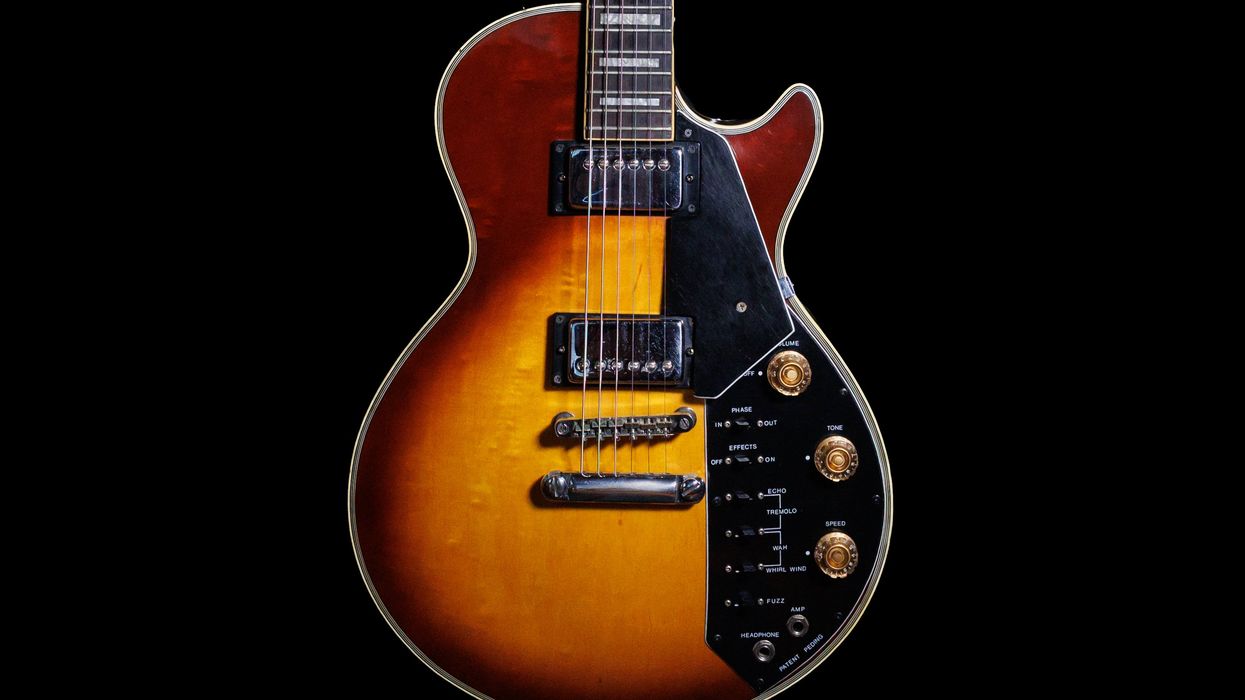
Guitar players today don’t know how good they have it. Inexpensive guitars imported from outside the U.S. are widely available, dependable, and high quality for the price. Folks in the ’60s and ’70s weren’t so lucky. Most instruments made at beginner-friendly price points by brands like Harmony and Kay were inferior to the Martins and Gibsons they copied, but a top-of-the-line Harmony had high-end features. Once you started looking at models with fancy inlays and multiple pickups, some cost even more than low-end and mid-priced Gibsons.
As the popularity of the guitar soared, so did the demand for even cheaper options. Harmony and Kay couldn’t keep up, and American importers noticed an opportunity in Japan. But as the yen gained strength, importers started looking for even lower-cost manufacturing and found it in Korea.
A young company called Samick sprang into action. Originally an importer of Baldwin pianos, they rapidly expanded their production capabilities with a factory able to make one-million instruments per year. Great news for American importers, but perhaps less great news for American guitar beginners. The market was soon flooded with Korean guitars still in their trial-and-error era. Truss rods were non-adjustable decoration. The finishes were no match for the heat and humidity of container ships. Hardware made from cheap die-cast aluminum was prone to snapping in half. Needless to say, early Korean guitars developed a bad reputation.
So when this Samick-made Les Paul copy came through the doors of Fanny’s House of Music, expectations were low. The floppy-looking bolt-on neck and blank headstock trigger a trauma response in guitarists of a certain age. But once you try it, all the bad experiences melt away like so much nitrocellulose on a container ship. The action is extremely low at 2/32", but it somehow still has “resistance” that feels so good—the kind that lets you dig in and get a different sound. The frets are worn but well cared for. Whoever used to own this beauty didn’t let it go too long without a crowning.
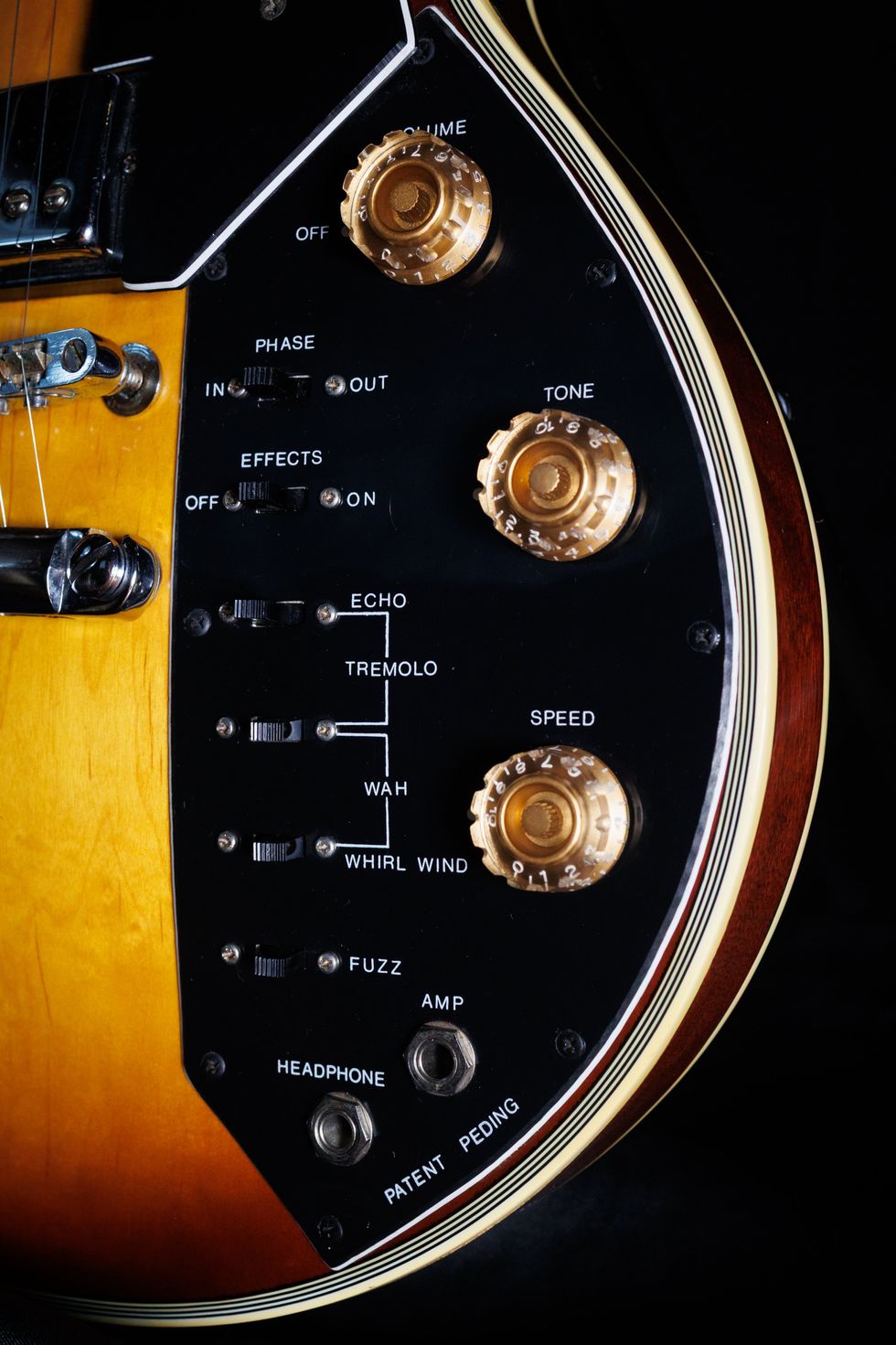
“Everything about it, we were like, ‘Wait, this shouldn’t be this good!’” Fanny’s owner Pamela Cole says, with a laugh.
Kay went under in the late ’60s, and its assets were auctioned off in 1969. The rights to the name were acquired by an importer called Weiss Musical Instruments, whose primary brand was Teisco del Ray. Calling their guitars “Kay” gave them more credibility with dealers, even if the guitars were essentially Teisco del Reys with a different name on the headstock. They certainly didn’t resemble the old Kays one bit.
“The hardest thing about adding a 3-way switch would be finding the real estate.”
In the Sears catalogue, this model was called the Kay Effector. Its flight-deck-esque array of switches and knobs sits atop a spaghetti plate of cables and components. There are two single-coil pickups in humbucker-sized housing, which are both always on. There’s no pickup selector. Intrepid modders take note: The hardest thing about adding a 3-way switch would be finding the real estate. Included in the flock of switches are one that flips the pickups out of phase (hip!) and one that turns the built-in effects on and off.
Only one of the Effector’s effects feels familiar: The fuzz has a Muff-like quality but is more of a distortion than a fuzz. The four modulation effects—echo, tremolo, wah, and the intriguingly-named “whirl wind”—sound similar once you start playing around with them. A poke around the schematic reveals why: All the modulation effects work off the same 2N2646 unijunction transistor, which mega-nerds may recognize from the classic Vox Repeat Percussion. In fact, each modulation effect is the same, hitting different capacitors along the way to give each one a subtly different sound. This author enjoyed “whirl wind” the best, partly because it had the most fun name, but also because it had a dynamic, “reverse-sawtooth” feel.
Guitars like this Samick-made Kay Effector are artifacts from a transitional moment in gear history, when manufacturers were learning on the job and players were beta testers. A guitar that once felt like a compromise now feels like a hidden gem. It’s a reminder that innovation and excellence don’t always come from the top shelf. Perhaps the weirdest instruments are some of the best; they just never had a chance to be taken seriously.
Reverend Guitars Launches Bold New Spacehawk Supreme
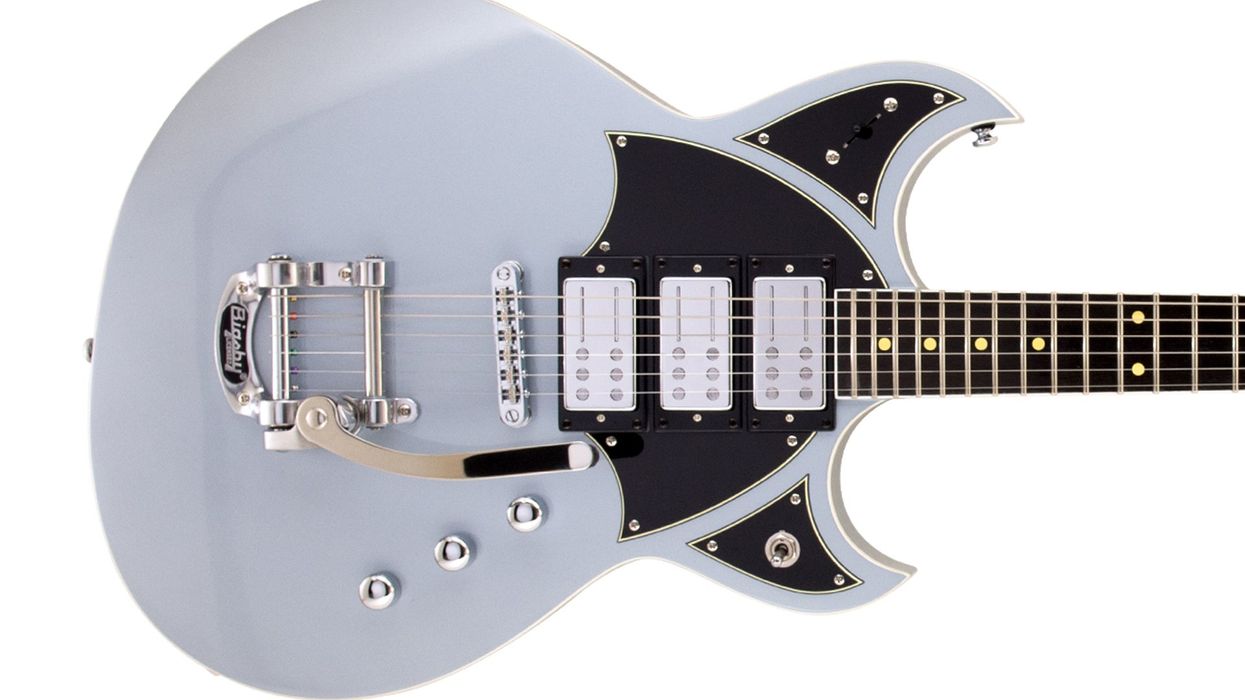
Three pickups, seven combinations, endless sonic options

 Reverend has unveiled the Reeves Gabrels Spacehawk Supreme, the latest version of the innovative Reeves Gabrels Spacehawk.
Reverend has unveiled the Reeves Gabrels Spacehawk Supreme, the latest version of the innovative Reeves Gabrels Spacehawk.
The new model sports three Railhammer pickups: an Alnico Grande at the bridge, a Hyper Vintage in the middle position, and a Hyper Vintage at the neck. Packed with features, the Spacehawk Supreme offers a bevy of switching options to supplement its 5-way pickup selector. The Reverend Studio Switch adds the bridge pickup (push-pull volume knob) allowing a total of seven pickup combinations, plus the guitar provides a push-pull phase switch in the tone knob. Last, but not least, the guitar features a kill toggle for instant on-off.
Sporting a Bigsby tremolo, the Spacehawk Supreme is available in two eye-grabbing finishes: Metallic Silver Freeze or Venetian Gold.
The Reverend Spacehawk is the guitar that Reverend Guitars designed for Reeves Gabrels when he joined The Cure. It is the sixth signature model for Gabrels from Reverend Guitars.
Reverend’s new Reeves Gabrels Spacehawk Supreme carries a street price of $1699. For more information visit reverendguitars.com.
Badlands Guitar Company Unveils the Limited Edition GX1-PRO Guitar
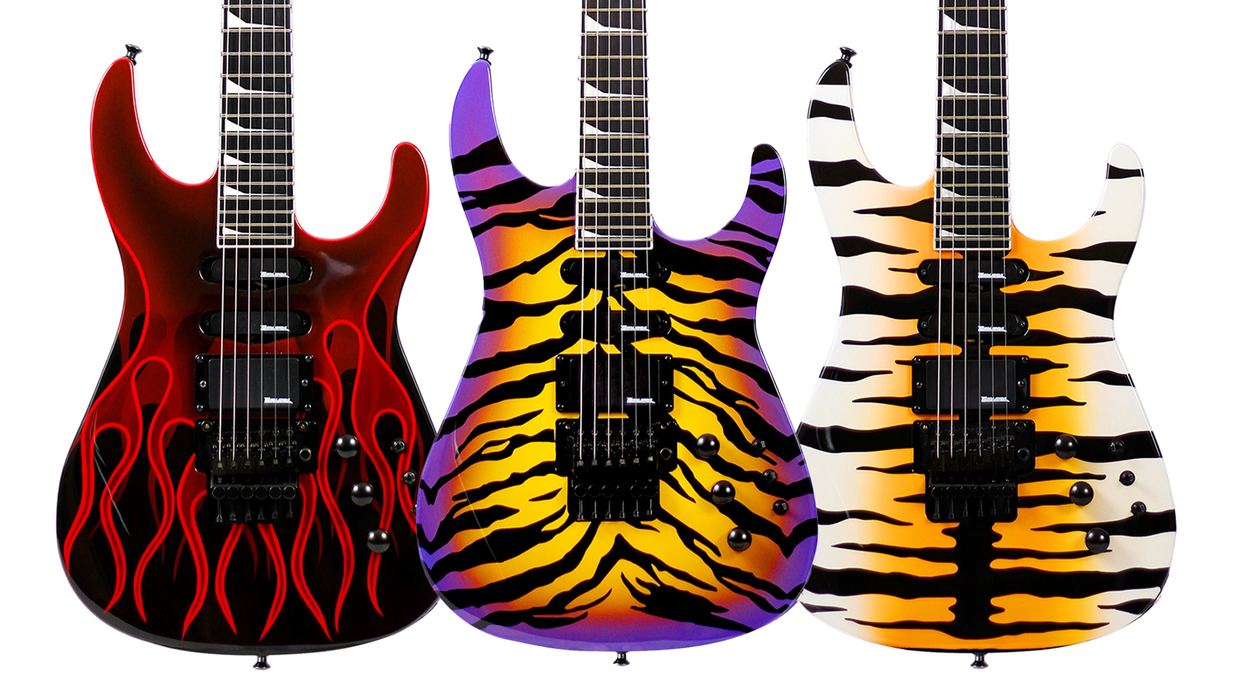
Limited to only 100 pieces, Badlands Guitar Company announces the release of its USA made GX1-PRO, available August 1 direct from the factory or at select retailers.
Purpose-built for players who came of age in the golden era of 1980s rock and metal, the GX1-PRO channels the high-octane spirit of that decade with custom-shop precision and modern performance refinements. Built exclusively in Maryland and available in either right or left-handed configurations, these arena rocking instruments fuse aggressive styling with hand-selected components for players seeking tone, playability, and attitude in equal measure.
The GX1-PRO features an alder body and a three-piece, quarter sawn maple neck-thru design, reinforced with carbon fiber rods and a dual-action truss rod to ensure exceptional sustain and resonance. The Custom series offers hand-painted finishes including Mystic Blue HotRod, Inferno Red HotRod, Sunset Bengal, and Retro Bengal. Available in the Classic series are solid finishes including Midnight Blue, Arrest Me Red, Taxi Yellow, and White Wedding Pearl. All finishes are polyurethane and an unmistakable homage to the high-octane visual style of the 80s. The 25.5” scale, ebony fretboard is loaded with 24 Jescar nickel silver frets and shaped with a compound radius of 12”-16”. Finished in matching paint, the ‘80’s select neck profile and 1 11/16” nut width provides comfort and easier playability. A tilt back headstock and Sperzel locking tuners improve sustain and tuning stability while Badlands Guitar Company's signature mother of pearl "Railroad Spikes" inlays and white binding add a touch of classic elegance.
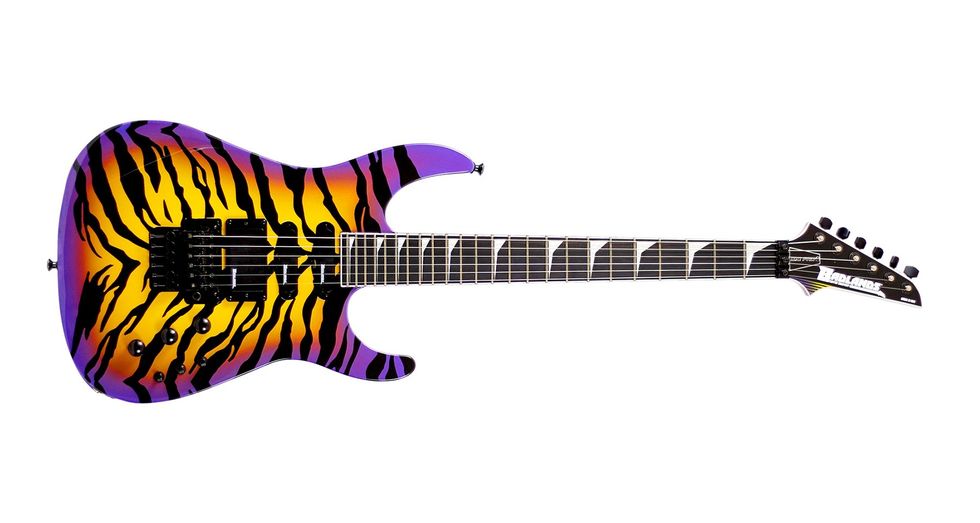
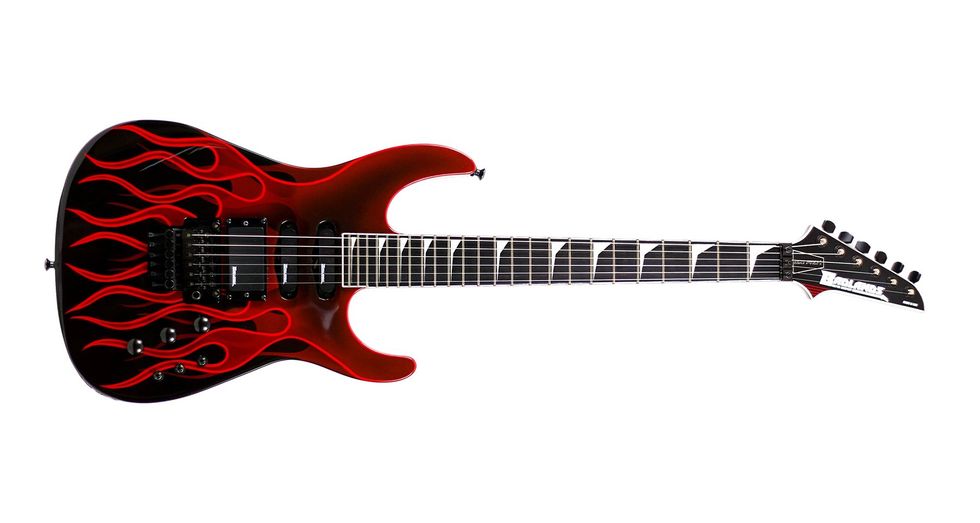
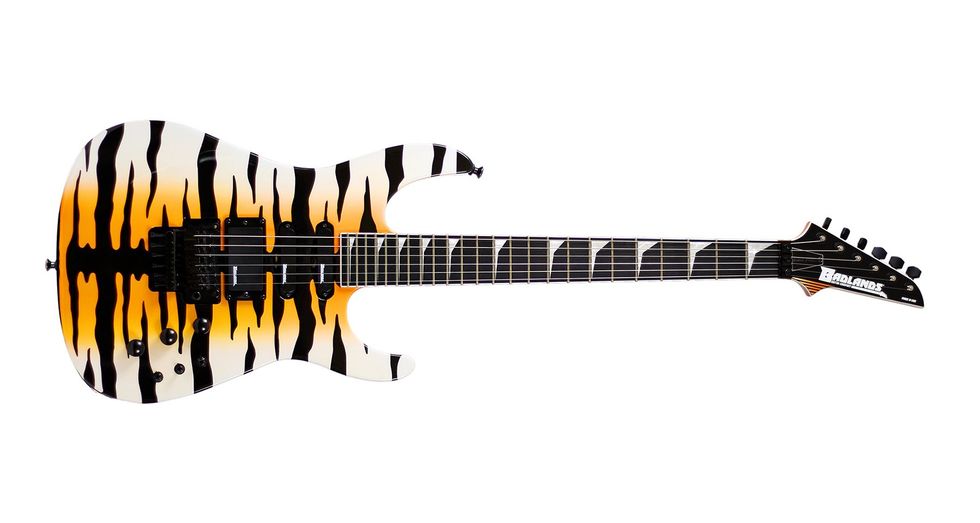
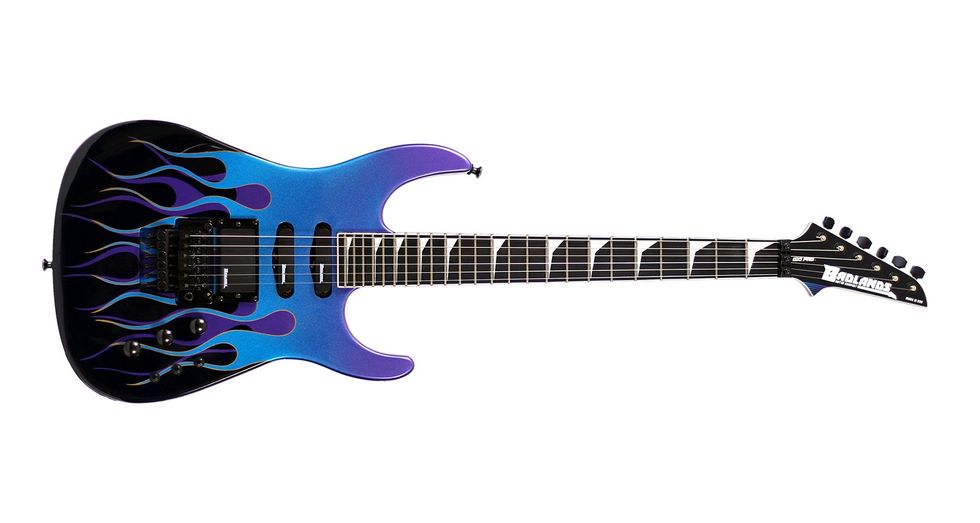
Just like any hot rod, custom paint is only half of the equation. What is under the hood is always what matters most. The GX1-PRO is engineered for powerful, versatile tones. Loaded with an H/S/S configuration, the custom-designed, handwound BGC M89 ceramic humbucker in the bridge position meticulously delivers an aggressive growl reminiscent of the era's most iconic high-performance pickups. This is perfectly complemented by two specially voiced BGC M81 single coils. The control layout features a trio of mini toggle switches, offering a wide array of tonal shaping options, consistent with classic 80s setups. A newly developed BGC1200M Midboost circuit, a first for Badlands Guitar Company, further expands the guitar's sonic palette, allowing players to dial in a diverse range of sounds from searing leads to articulate rhythm tones. The USA Floyd Rose bridge, locking nut, metal knurled knobs, and football jack cover are all appropriately finished in black.
Each GX1-PRO arrives set up with SIT Strings and ships with a premium embroidered Badlands G&G case, ensuring secure transport and protection. Case candy includes a Certificate of Authenticity, QC card, VIP Backstage Pass lanyard, pin and sticker set, a Dunlop System 65™ Multi-tool, and a limited edition framed poster uniquely matching the very guitar ordered.
For more information, please visit www.badlandsguitarcompany.com.
Street Price:
GX1-PRO Custom HSS $3499.00 USD
GX1-PRO Classic HSS $2999.00 USD
Tech 21 Killer Wail v2 Review
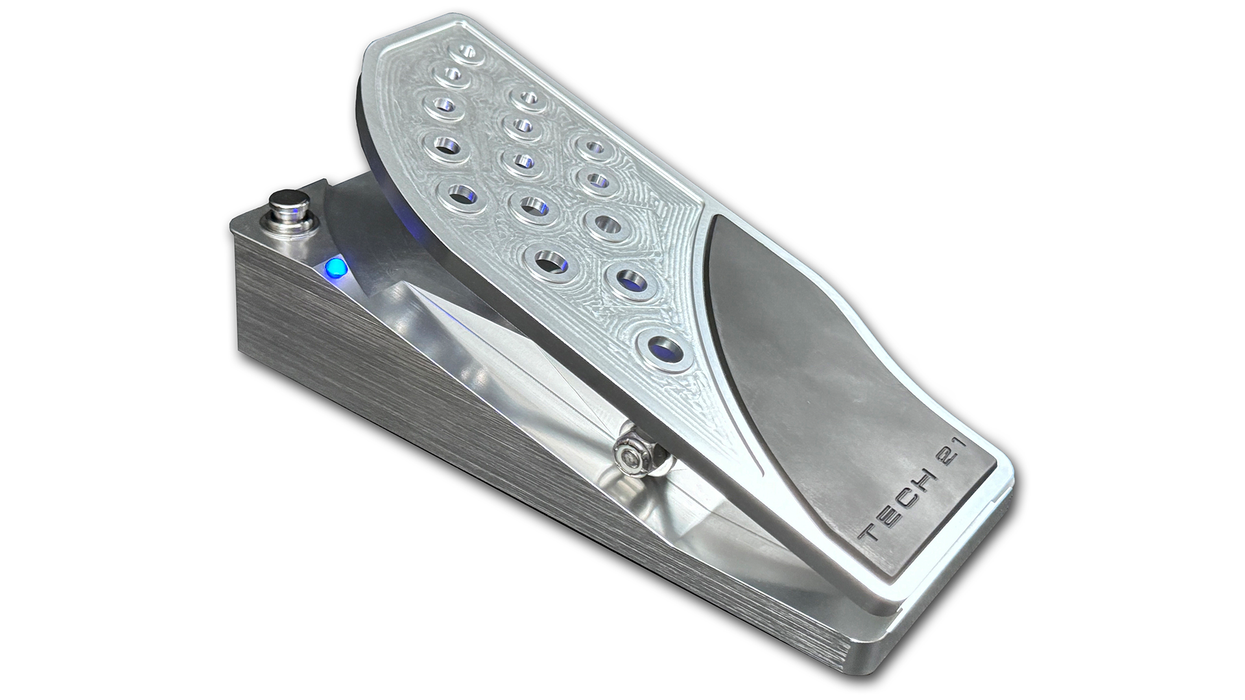
Tech 21’s original Killer Wail was an under-the-radar wah that gathered a great reputation among those in the know. After a complete redesign, Tech 21 released the Killer Wail v2, as well as two other wahs—the Richie Kotzen Signature wah and the Killer Blue Wail (for bassists). These are a significant departure from the original Killer Wail.
Machined from solid billet aluminum, the Killer Wail v2 is sturdy yet light. In fact, my Cry Baby weighs more than twice as much. It’s sleek—almost aerodynamic if such things were a consideration for wah pedals—with little of the bulk associated with conventional wahs. With its compact footprint and top-mounted jacks it’s also pedalboard friendly, a claim few wahs can make. It can also be operated via a 9V battery or DC power supply.
A Wah for Modern Times
A nice vintage wah exudes, well, mojo. That’s the nature of the effect, and a fact we can probably all agree on. But the mechanics of most wah designs come with downsides. The majority of wahs (vintage and modern) employ pots that tend to get noisy and scratchy, and if used heavily will ultimately need replacement. The Killer Wail v2 eliminates these issues by using a light sensor instead of wah pots. Theoretically, the light sensor will almost never wear out. This isn’t a new solution—Morley’s beastly chrome wahs from the 1970s famously employ optical sensors, and continue to do so. But they are a very practical—and quiet—alternative to conventional filter pots that tend to act like dust magnets.
Tech 21 also equips the wah with a silent buffered bypass switch positioned at the top left corner. A blue light beneath the button glows red when the pedal is engaged. According to Tech 21, the actuator is rated for a million uses, so durability shouldn’t be a concern.
The Killer Wail v2’s proprietary filter delivers a distinct feel. As expected, toe-down boosts the highs—but even without distortion, your tone stays rich and warm while still slicing through a band mix. Add a drive pedal after the wah, and that tonal character pays big dividends, yielding biting, aggressive, and warm tonalities that are ideal for screaming solos.
Heel-down, the pedal boosts the low end, creating a softened attack that lends sustained chords an almost Fender Rhodes-like feel. Engaging a drive pedal brought out creamy, vocal-like lead tones. Placing gain pedals before the wah allowed for slightly glitchy, synth-like sounds on single-note lines, in addition to more conventional percussive wah textures.
The Killer Wail v2 may not be the most budget-friendly wah out there, but its combination of long-term durability, expressive tone, and smooth, natural sweeps makes it feel like a solid investment—from heel to toe.
Berserker Electronics Launches the “Velcrow”
A fierce and flexible Gated Fuzz for modern players.
Berserker Electronics, creators of the Prehistoric Dog preamp and Aquanaut delay, has announced the release of their latest sonic weapon: Velcrow – a raw, percussive gated fuzz pedal designed for players who crave filthy textures with tight control.
Inspired by the beloved and discontinued Way Huge Conquistador, the Velcrow takes that sputtery, aggressive sound and pushes it further – offering more dynamic range, more usable tones, and a sharper, more responsive gate. Velcrow is built to deliver snarling fuzz with a snappy gate, thriving on punchy riffs, abrupt cutoffs, and glitchy sustain.
Despite its intensity Velcrow is also intuitive to dial in, with carefully tuned controls that let you shape your attack and decay without ever sounding flabby or buried.
Key features include:
- Inspired by the Way Huge Conquistador, but with expanded range and control
- Tightly gated fuzz with sharp attack and fast decay
- Simple, intuitive controls in a pedalboard-friendly enclosure
The Velcrow is available direct at www.berserkerpedals.com. Street price is $129.
Alan Sparhawk Gets By With a Little Help From His Friends
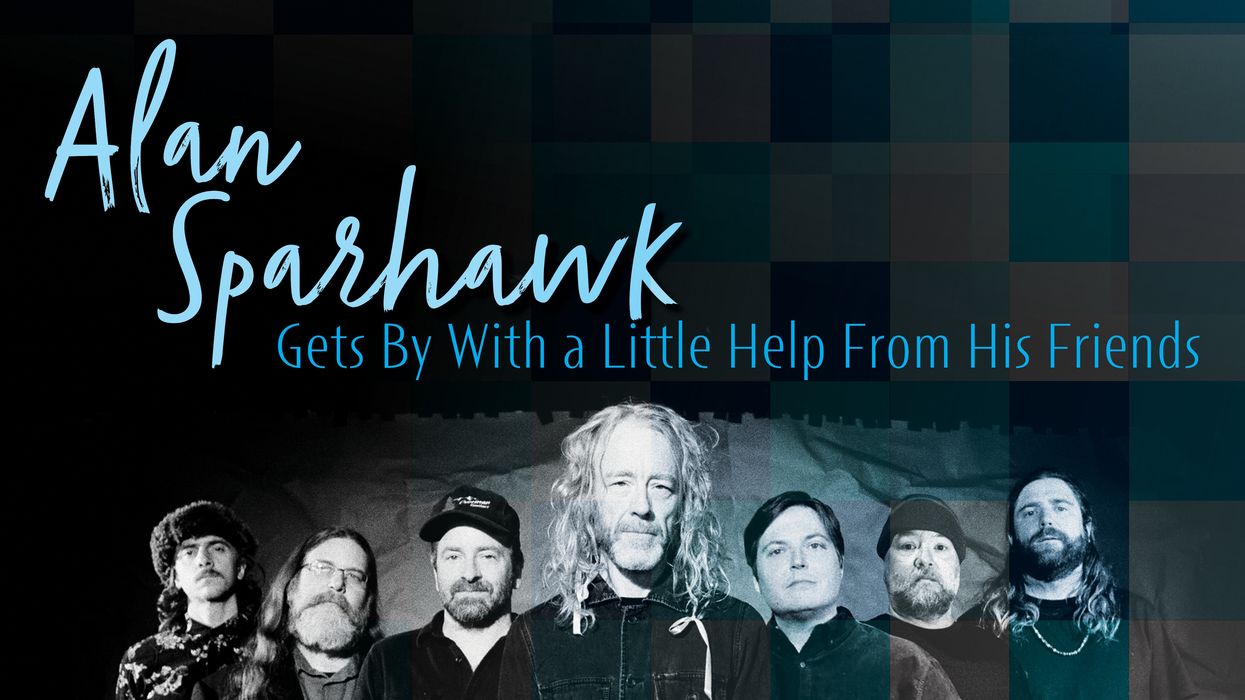
Alan Sparhawk has been a friend of Trampled By Turtles for a long time. Both parties came up in Duluth, Minnesota, and Low—Sparhawk’s often ethereal slowcore band with his wife, Mimi Parker, who died from ovarian cancer in late 2022—took Trampled By Turtles out on the road very early in the latter’s career. But few would’ve expected a studio collaboration between Sparhawk and the bluegrass merchants.
With Trampled By Turtles makes one wonder why. The record is deeply moving, often pulsing with powerful forward momentum, driven by Sparhawk’s unadorned voice like a herald calling out that something heavy this way comes. Of course, it arrives—especially in the bruised ecstasy of “Screaming Song” and the mournful “Don’t Take Your Light.”
“Some of the songs are the first things that fell out of me in response to loss and grief,” Sparhawk says over the phone from the Quad Cities, on tour with Circuit des Yeux. “Some of them are pretty pointed, and I really felt the duty to do those songs justice, to honor them for what they were and what they came from. White Roses, My God was literally just my head exploding and me running away from the guitar and from my voice and trying to figure out some way to let this explosion out of my skull, this screaming, you know? And this thing with the Turtles is the first breath.”
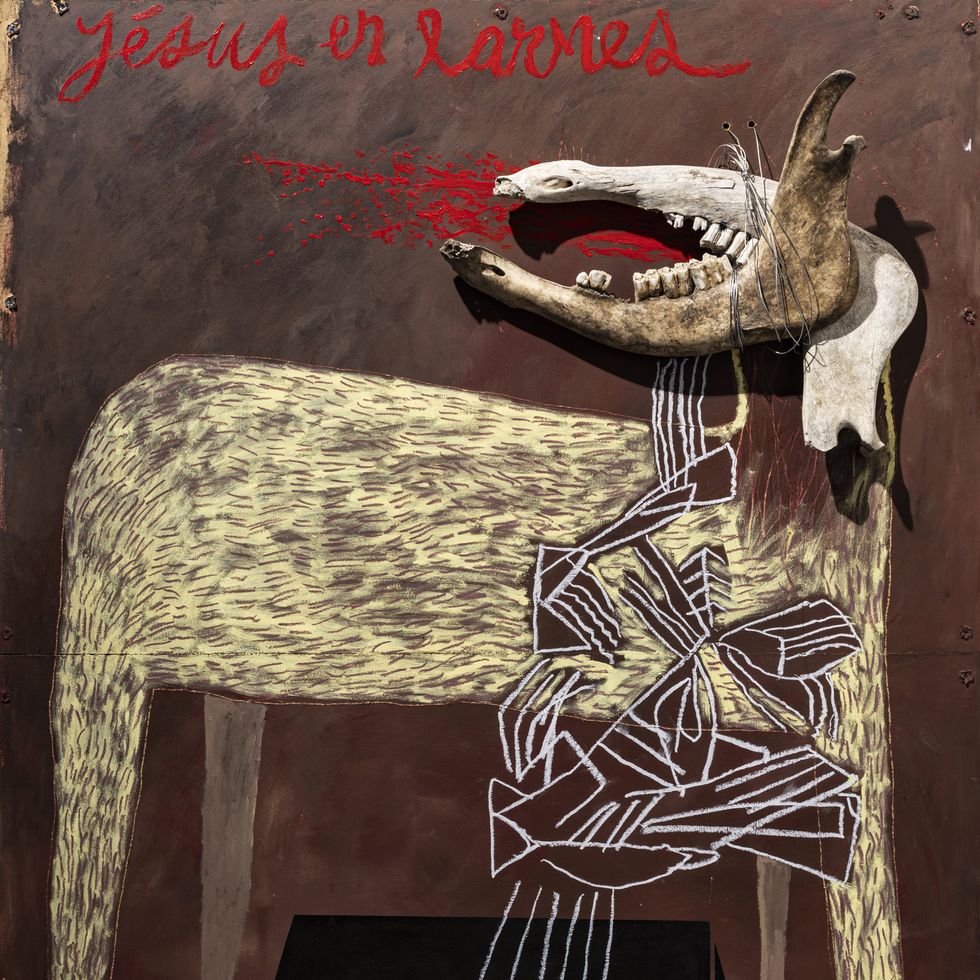
The two albums were recorded around the same time—even sharing the songs “Heaven” and “Get Still”—but they’re polar opposites, sonically. White Roses, My God trades in all-encompassing electronic soundscapes and so much vocal modulation that Sparhawk is unrecognizable, while With Trampled By Turtles feels stripped down, and features his voice rising clear above the bluegrass group’s earthy, mostly acoustic string work.
“It’s this unified wall of strings coming at you,” Sparhawk says about Trampled By Turtles. “There’s something egoless about the way they play together and the way they make sound. It doesn’t get broken down the same way a lot of bluegrass ensembles approach things.”
“I remember being still pretty scared and uncomfortable with my voice after years of singing with Mim and from the loss in general.”
After Parker died, Trampled By Turtles extended Sparhawk an invitation to hit the road for a few dates with them, an experience that brought the two closer and planted a seed that bloomed in Cannon Falls, Minnesota, in the winter of 2023. Sparhawk came in at the tail end of a Trampled By Turtles recording session there with a handful of songs, some old, some new, and the album came together swiftly. The result is a recording that foregrounds feeling, naturality, and spontaneity—more a pouring out than a piecing together. It’s often jarring how bare Sparhawk’s voice is, akin to an exposed nerve. It sounds more than a bit like a leap of faith, and he mentions that his only skill is diving into the unknown. “I’m quick to jump off the cliff,” he says.

“I remember being still pretty scared and uncomfortable with my voice after years of singing with Mim and from the loss in general,” Sparhawk says. “It really was making me feel very, very lost and awkward, singing. And I think during this Turtles thing—because this opportunity had come up and these guys had been so friendly and gracious with me—I consciously remember having to go, like, ‘I know I’m still not comfortable hearing my voice right now, but I have to just trust. I have to trust that this is what I can do, that I can sing, and that I’ve been working hard on this all my life. For the sake of the moment, put aside my confusion, and just trust that maybe five or six months down the line, I’ll be able to look back and decide whether I was comfortable with it or not.’ And honestly, it helped.”
“When I was a teenager, I remember very specifically saying that I like the guitar, and I really wanted to take it seriously, and I made a pact with myself to play it every day.”
It also marks a coming back to guitar for Sparhawk, the instrument that remains his “main physical connection to music.” But one needs to get away to come back. He thrives off of switching things up, much more able to see the big picture when he’s thrown into situations where he’s doing different things and forced to look at music differently. He says he struggles with the guitar, and has to practice often to stay fluent with what he wants to do. An opportunity to ponder something he hasn’t pondered, or play in a way that he hasn’t quite had to before, is always positive for him.
“I’ve always insisted on playing every day,” Sparhawk says. “When I was a teenager, I remember very specifically saying that I like the guitar, and I really wanted to take it seriously, and I made a pact with myself to play it every day. So it’s always there. It’s a world in my brain that I feel pretty happy in. But at the same time, I have to constantly be engaged with it to keep my footing there.”
Alan Sparhawk’s Gear
Guitars
1960s Danelectro Convertible
1970s Gibson Hummingbird
Amps
1960s Silvertone amp
Fender Pro Junior (small stages)
Fender Twin (large stages)
Effects
Chase Bliss Onward
Chase Bliss Mood
Red Panda Tensor
ZVEX Octane 3
ZVEX Box of Rock
Boss synth pedal
Tech 21 Double Drive
Strings
D’Addario strings (.011-.056)
His own approach to music-making and his musical community seems to be providing plenty of opportunity for challenges; the doomy goth-rock of Circuit Des Yeux sounds worlds apart from With Trampled By Turtles, which sounds worlds apart from White Roses, My God. And yet, it all exists in Sparhawk’s musical world—a world he says he feels blessed and grateful to be in, one that fascinated him as a child and that he wanted to be a part of. It’s given back in spades, too. Low, of course, was a family affair, and so is this new record, on which Sparhawk’s daughter, Hollis, also sings, during the chorus of “Not Broken.” One gets the feeling that connection has always been the point.
“Anyone who’s been blessed with friends that are there for them when they’ve had losses—those are the most important things in life,” Sparhawk says. “I think music is there to remind us of that, and give us a really amazing opportunity to feel that with each other and to bless each other.”
YouTube
Lose yourself in this peaceful, psychedelic rendering of “Get Still,” off of With Trampled by Turtles.
When Dave Grohl Used an Amp in a Gas Can to Make Foo Fighters’ Lo-Fi Debut
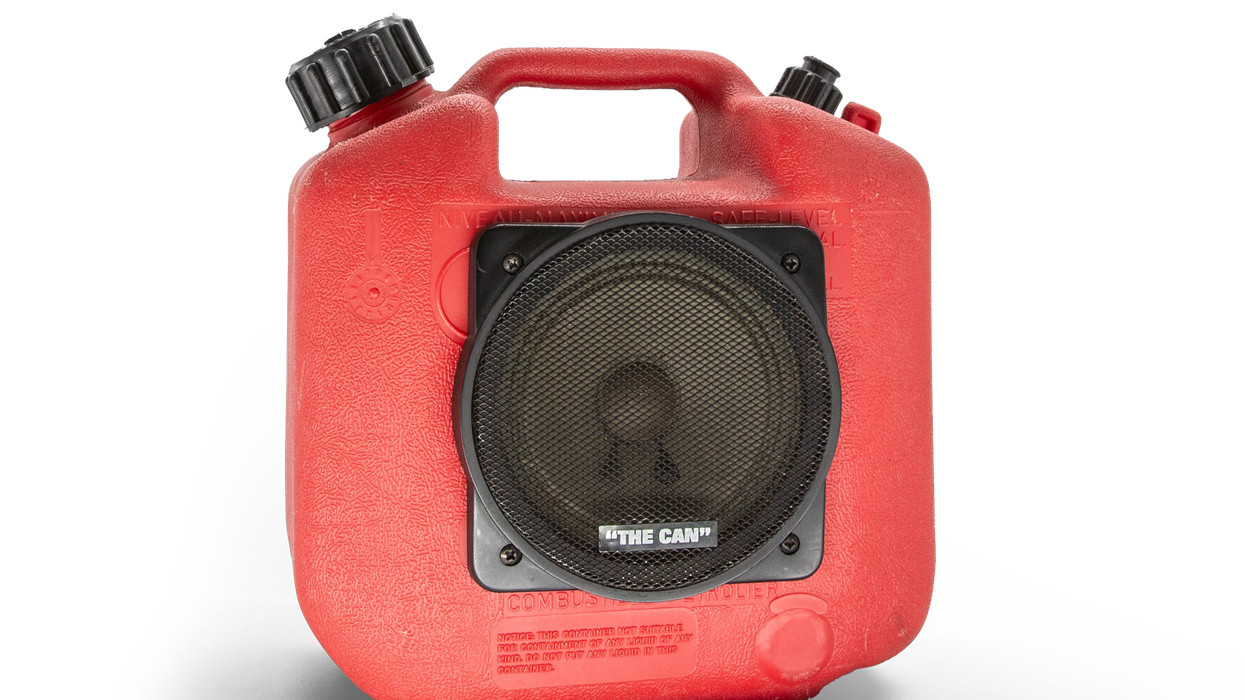
This year, the Foo Fighters’ self-titled debut turns 30 years old. As a nearly obsessed fan of the band since 2011’s Wasting Light, I’ve developed an exceptionally strong attachment to the first album. By now, we all know the story: Following the tragic and sudden end of Nirvana, Dave Grohl found himself searching for the right way to start making music again. In October 1994, he booked a week at Robert Lang Studios in Seattle, Washington, with producer Barrett Jones, and they got to work recording what would become the debut Foo Fighters album. This release would serve as the foundation for the band’s tenure at the forefront of modern rock for decades to come.
There is something uniquely nostalgic and spontaneous about the sound of Foo Fighters. The crunchy guitars and uptempo beats are straight off the heels of the grunge movement, with elements of punk and metal—staples of Grohl’s musical influences growing up—plus a sweet, melancholy shoegaze vibe, which permeates songs like “Floaty” and “X-Static.” These recordings are lo-fi, but still deliberate and precise, a testament to both Grohl’s skill as a musician as well as the limited session time allotted to complete the album.
The gear used to record this album has always been an intriguing mystery to me, and one piece specifically kept popping up in my research: an amp known as the Can. Over the years, both Grohl and Jones have cryptically mentioned a mythical amplifier that provided the most glorious, disgustingly raunchy fuzz tones, heard most notably on closing track “Exhausted.” For a long time, fans online talked about a “gas-can amp,” an “oil-can amp,” or even some claiming the effect was achieved by placing a microphone into a metal can next to a guitar amp—nobody was quite sure what exactly the source of this sound was.
In 2021, Jones hosted an “ask me anything” live stream on his YouTube channel. I was lucky enough to catch it, and the first question I asked was about this mystery amp. That’s when I first laid my eyes on the Can. It’s literally what it sounds like: a small, battery-powered practice amp built into a red plastic Jerry can. My mind was blown; I needed to know more.
“I had to take a moment to step back from the situation and admire how silly it was to be so excited about this; objectively, this amp sounds terrible, like a swarm of bees rattling around in a plastic jug.”
The story goes that SLM Electronics, an amp-manufacturing division of St. Louis Music, produced these amps in the mid ’80s as a battery-powered solution for buskers. As a novelty, they created a plastic enclosure that resembles a plastic gas can for the solid-state amplifier controls as well as the 5" speaker. Approximately 10,000 of these amps were manufactured and distributed out of the same factory where the original Crate amps were made in the U.S.
Once I learned exactly what this amp was, my mission became clear: I needed one.
I quickly discovered how difficult it is to find these amps. Even as a seasoned gear-hound, well-acquainted with the standard practice of scouring Reverb, eBay, Musician’s Friend, and every other source where used musical equipment can be found, I was coming up empty-handed. My searches resulted in a few expired Reverb listings from years earlier of people selling these amps for dirt cheap, which, while frustrating, yielded an encouraging sign that the lore behind “the Can” was not yet common knowledge. My worst fear was that word would get out about these amps and we’d end up with another instance of PDS: Peavey Decade Syndrome. (If you know, you know.)
In a turn of miraculous serendipity, I stumbled across someone selling one on Facebook Marketplace and jumped on it. I’d managed to snag my very own Can amp. I had to take a moment to step back from the situation and admire how silly it was to be so excited about this; objectively, this amp sounds terrible, like a swarm of bees rattling around in a plastic jug. However, when I finally plugged in my guitar for the first time and strummed that first D minor chord from “Exhausted,” I knew immediately: That’s the sound.
The simple truth I’ve come to terms with over the years as a guitarist is that “good tone” is purely subjective. Especially in a studio setting, some of the most iconic sounds can be uncovered in the most unconventional ways, and the Can is a true testament to that statement. While the early days of Foo Fighters were undoubtedly cast in the looming shadow of Nirvana’s massive success and catastrophic end, I think it’s finally time we recognize Grohl’s 1995 solo effort for what it is: a truly magical little slice of mid-’90s post-grunge that still packs a mighty wallop 30 years later. And in the middle of it all, this crunchy, fizzy, horrible little gas-can amp.
This Will Destroy You Rig Rundown
The doomgaze titans from Texas hit the road this year to celebrate more than two decades together, and they brought some of their favorite noisemakers for the occasion.
Post-rock/doomgaze outfit This Will Destroy You, formed in San Marcos, Texas, in 2004, are marking 21 years together, and 20 years of their self-recorded debut Young Mountain, with an anniversary tour. In late June, the band played Nashville’s Basement East, where guitarists Jeremy Galindo and Nicholas Huft and bassist Ethan Billips met up with PG’s Chris Kies to share what gear they packed for the roadtrip.
Brought to you by D’Addario
Trusty Tele
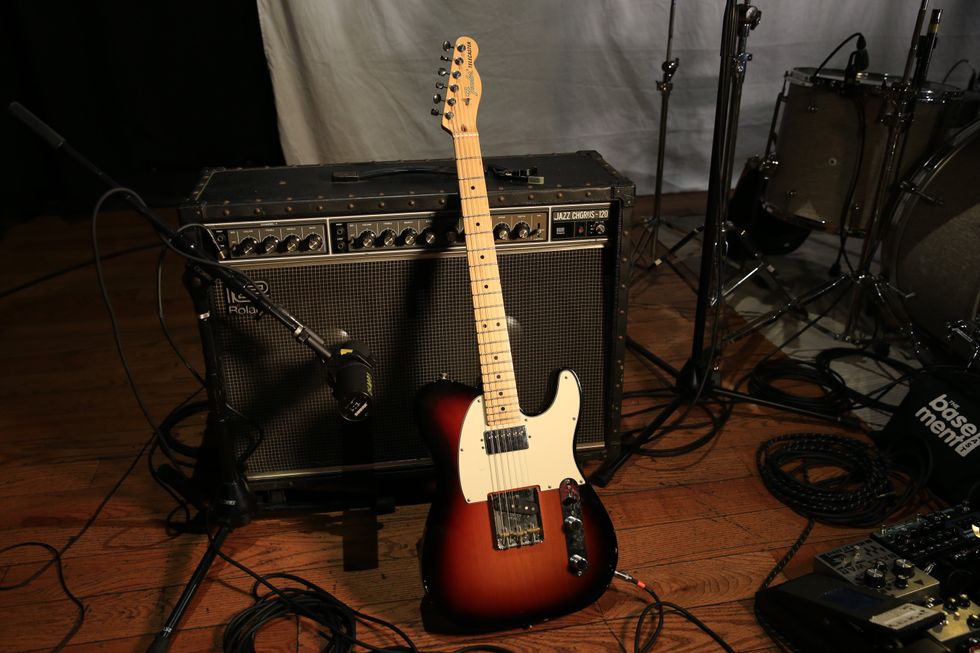
Galindo started off playing electric on his brother’s Fender Telecaster, and he’s never looked back. He’s played various models over the years, but got this Fender American Performer Telecaster two years ago. He strings it with .011–.052 strings for slightly more body and fullness, and tunes it to E-flat standard. Galindo mostly plays with his fingers, but when he picks he uses some of the thinnest picks he can find.
No Tubes? No Problems
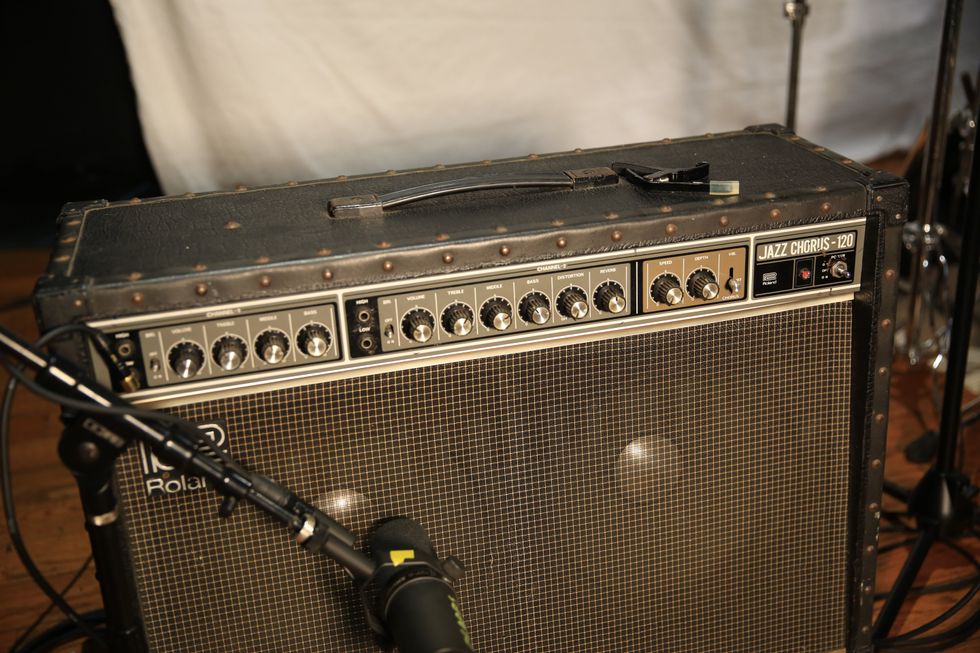
A Music Man HD-130 is Galindo’s always-and-forever, but on the road, he likes this Roland Jazz Chorus 120 for its tubeless reliability and easy clean sounds.
Jeremy Galindo’s Pedalboard
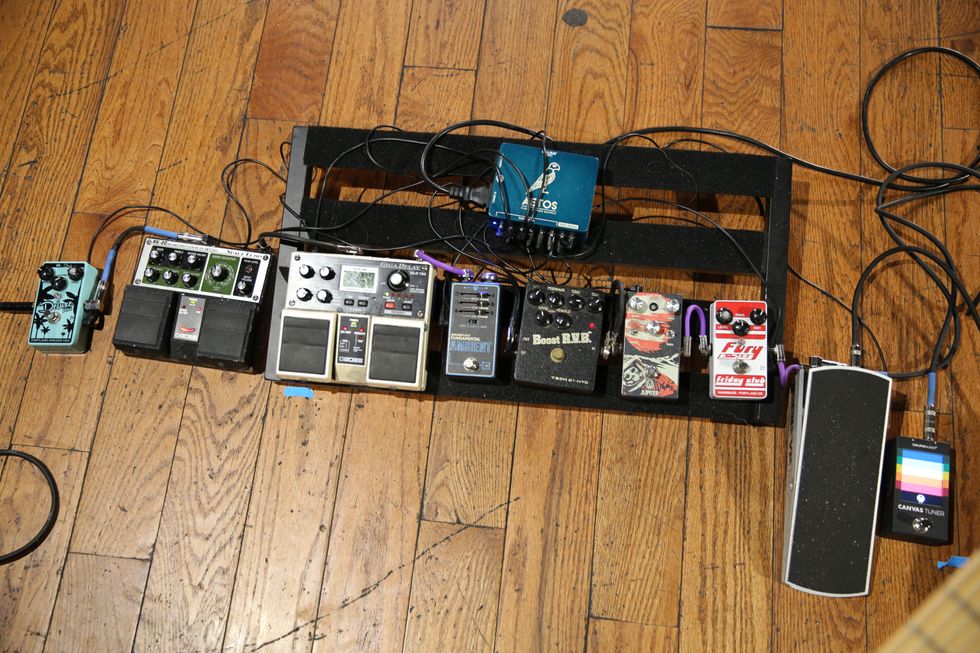
The Boss DD-20 Giga Delay and Tech 21 Boost R.V.B. have been with Galindo since the early days, and he considers the Tech 21 to be the most essential tool of his kit. Aside from those, there’s a Walrus Canvas Tuner, Ernie Ball VP JR, Friday Club Fury 6-Six, Walrus Jupiter, Walrus Fundamental Ambient, Boss RE-20, and Mr. Black Deluxe Plus. A Walrus Aetos powers the party.
Smooth as Sandpaper

This Fender Jazzmaster, Huft’s first, was bought from Full of Hell guitarist Spencer Hazard, who equipped it with its “awful sandpaper texture” finish. Huft doesn’t use the rhythm circuit, so he’s taped it off. He plays with both pickups engaged at all times, including the humbucker rail pickup in the bridge.
United Solid-States
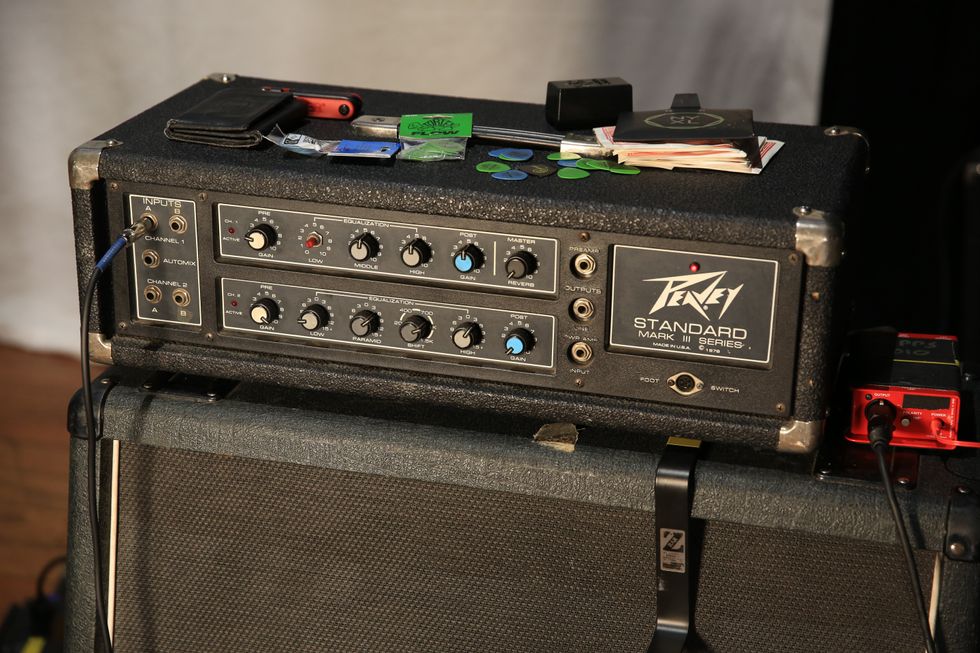
Huft has a soft spot for 1970s solid-state amplification, which makes this Peavey Standard Mark III series a perfect match for TWDY: It’s cheap, and it’s loud.
Nicholas Huft’s Pedalboard
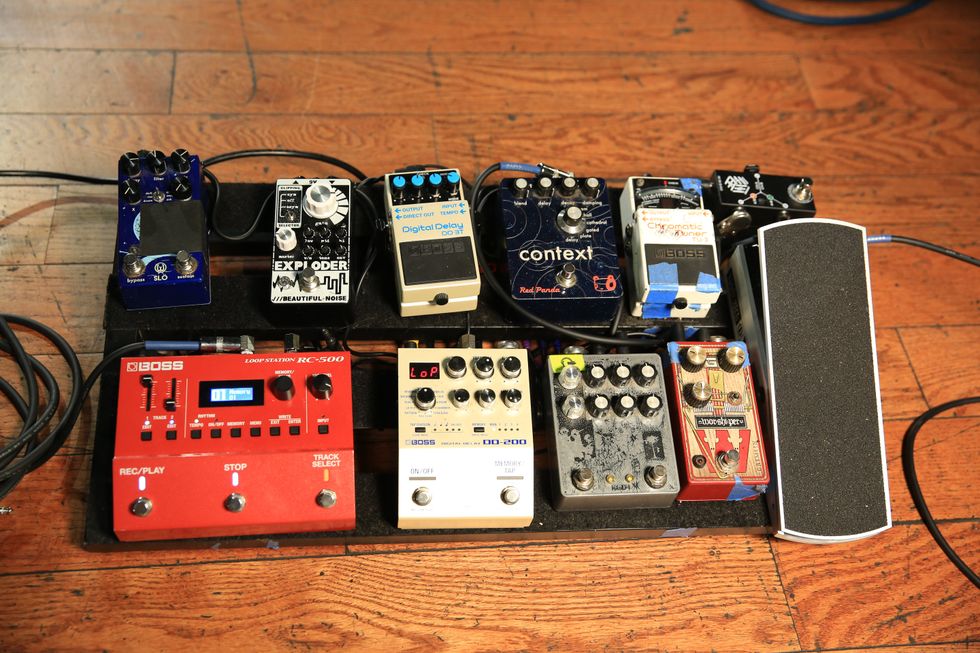
Along with an ABY switcher, Huft runs a Boss TU-3, Ernie Ball VP JR, Gremlin Machine Shop Worshiper, Dead Air Portrayal of Guilt/Matt King Dual Drive, Boss DD-200, Boss RC-500, Red Panda Context, Boss DD-3T, Beautiful Noise Exploder, and Walrus Slo.
Cheap and Cheerful
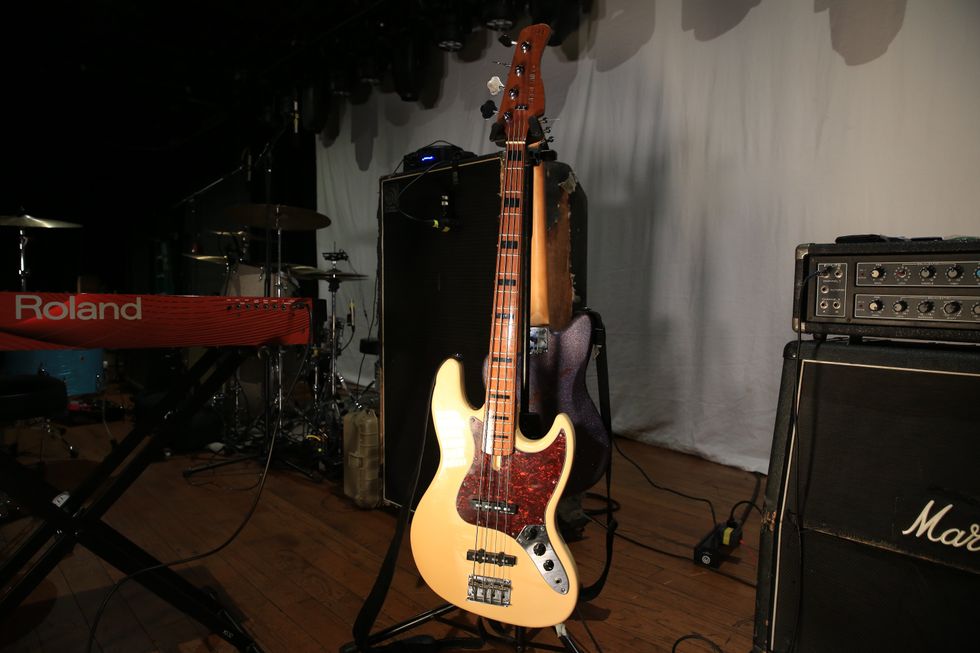
Billips explains that he and his bandmates grew up on cheap instruments, and they still feel like home, so that’s why he rocks with this Marcus Miller Sire bass.
Community Cranker
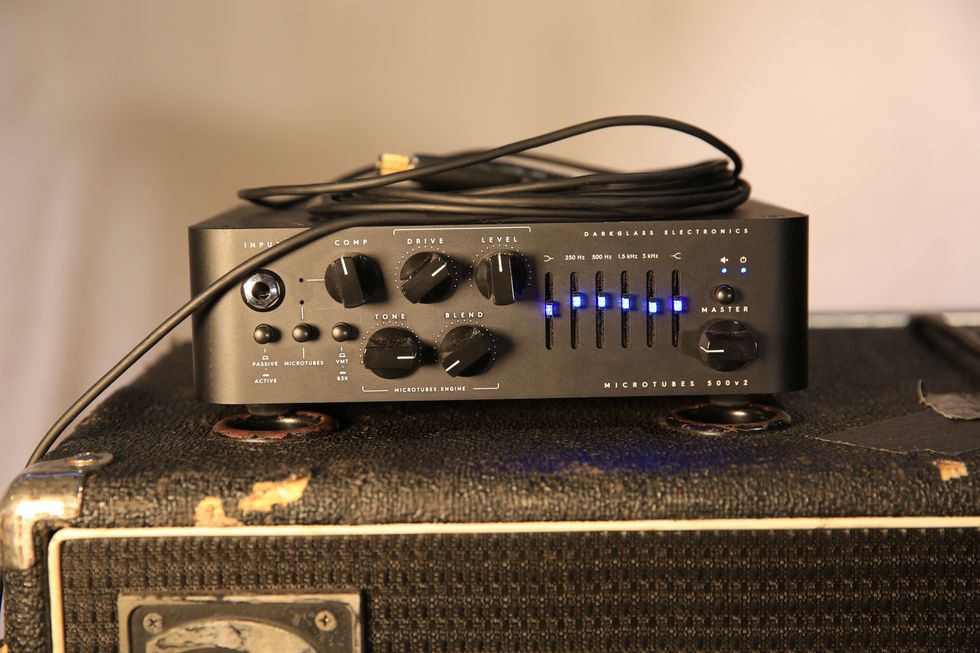
Billips and his bandmates split on this Darkglass Electronics Microtubes 500 v2 head, which they share collectively.
Ethan Billips’ Pedalboard
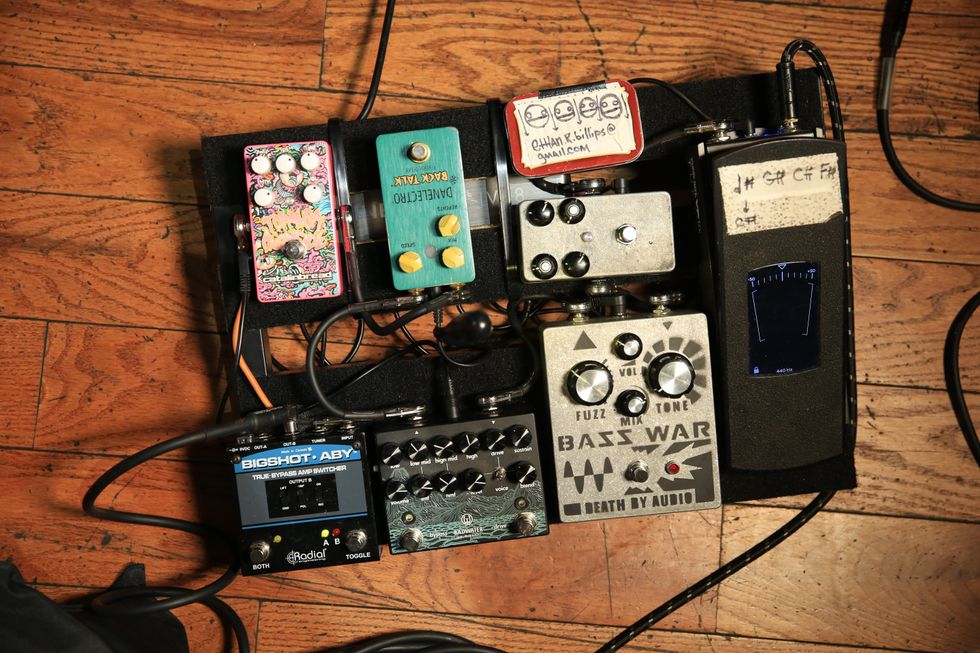
Billips runs an Ernie Ball VP JR Tuner, a prototype bass overdrive from Mr. Black, a Death by Audio Bass War, Walrus Badwater, Danelectro Talk Back, Catalinbread Topanga, and a Radial BigShot ABY.

Be More Like Led Zeppelin
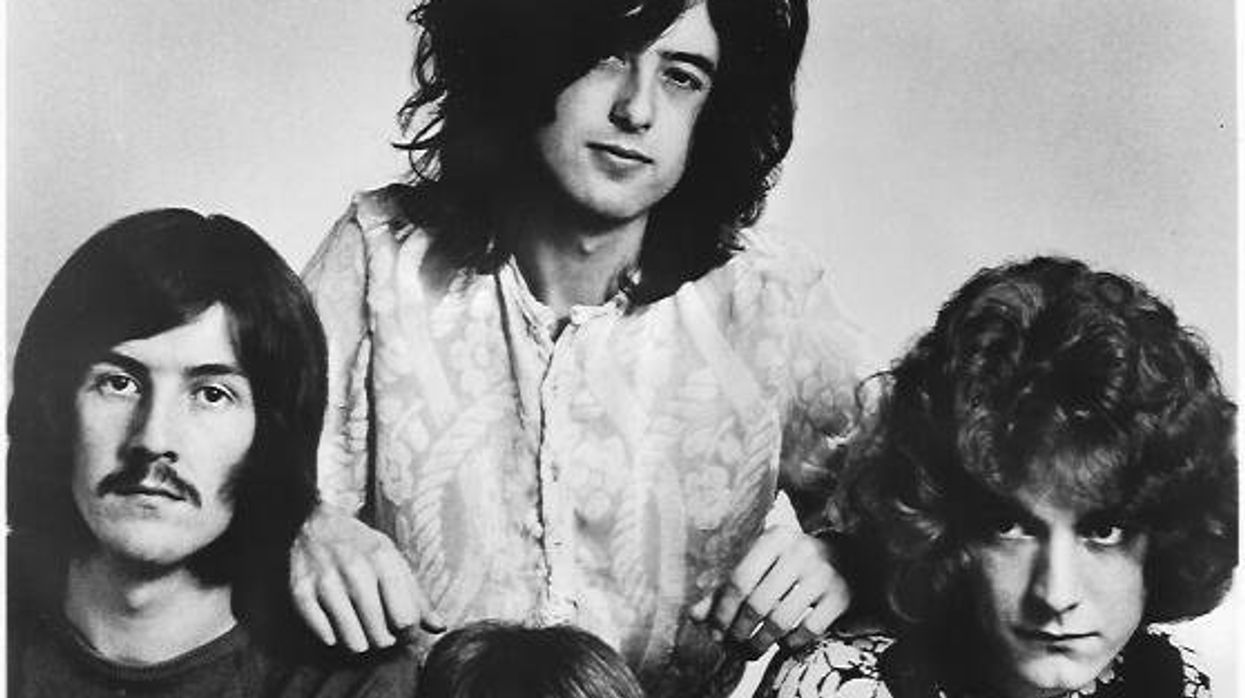
Making great music requires pushing the envelope, not pushing buttons.
As a teen, I signed over my soul to the Columbia House mail-order mafia and bought the first few Led Zeppelin albums. I wore those albums out, dropping the needle in front of the “Heartbreaker” solo, “Black Dog,” and “Stairway” daily. Eventually I moved on to other obsessions and forgot how amazing this band was—until last night, when I watched Becoming Led Zeppelin, Bernard MacMahon’s 2025 documentary. The film, which earned a 10-minute ovation at the Venice Film Festival and grossed $13.2-million by May 2025, charts the explosive rise of Jimmy Page, Robert Plant, John Paul Jones, and John Bonham from their 1968 formation to 1970’s global dominance.
Although Page and Jones had worked together as session musicians, the first time the Zep lineup played music together was a jam in a tiny, rented rehearsal room in 1968. They tested their collective sound, starting with blues standards like “Train Kept A-Rollin’” and “Smokestack Lightning.” Forty-four days later, they were recording their first album, which they completed in 36 studio hours. This raw fusion of blues, rock, and psychedelic chaos, using a 4-track recorder and a shoestring budget of £1,800 (about $4,300, then), helped usher along a paradigm shift in music. Tracks like “Dazed and Confused” and “Good Times Bad Times” took wild risks, blending modal riffs, orchestral swells, and improvisational fire. Led Zeppelin was also incredibly diverse, with the heavy blues balanced by the acoustic “Black Mountain Side,” which was inspired by folk and Indian music. Zep II pushed further, from the primal riff of “Whole Lotta Love” to the semi-pastoral “Ramble On.” Page’s violin bow on guitar and Bonham’s heavier-than-heavy drumming defied norms, while Plant’s primal vocals careened between octaves.
Most of today’s modern music is polished to predictability, sterilized, and quantized. I bet that 99 percent of the sessions I’ve played on over the past two decades were all built on a grid with a stagnant click. Zep’s approach to tempos is more like classical music, where the tempo follows the emotion. “Dazed and Confused” starts with a slow, brooding tempo (around 60 to 70 bpm) driven by a descending bassline and Page’s eerie guitar. The middle section accelerates into a frenetic jam (around 120 to 140 bpm), with Bonham’s aggressive drumming and Page’s wild soloing, before slowing back down for the haunting violin-bow section and a final explosive ramp-up to 140 bpm. On “Babe I’m Gonna Leave You,” the transitions are so abrupt it feels like a car ran a red light and hit your passenger door. Zep would have been boring if they were constrained by a click.“If ‘Stairway to Heaven’ debuted today, would anybody hear it?”
Zeppelin’s tones and timbres also kept it unpredictable and endlessly interesting. Although John Paul Jones’ ’62 Jazz bass, Bonham’s Ludwig Super Classic, and Page’s guitars did most of the heavy lifting, Zep gave us vast sonic variety. Between the four members, they played 15 instruments on their first three albums and went to great lengths to make every song its own, unique sound. Yet, regardless of the instrumentation, Zeppelin always sounds like Zeppelin.
Rock ’n’ roll was built on experimentation and rebellion. It’s truly a DIY genre. So how did modern rock become so homogeneous and tame? Today’s unlimited digital tracks and AI tools (used in 60 percent of 2024’s Top 40, according to MusicTech.com) encourage overproduction, smoothing all quirks along the way. Radio and streaming exacerbate this as labels push 3-minute singles with hooks in 30 seconds to fit ad-heavy radio and prevent Spotify skips. Zeppelin’s era had FM stations playing 7-minute epics. Today, labels prioritize safe bets, favoring formulaic hits over risks. Social media and streaming reward conformity—songs must grab instantly, not unfold like a movie. If “Stairway to Heaven” debuted today, would anybody hear it?
By comparison, the 1960s were an incredibly open-minded time. Labels were looking for something to take a chance on because the outliers were paying off. The Beatles, Bob Dylan, and Hendrix successfully took chances, which enabled others like Zep to push the envelope farther, paving the way for yet more experimental artists like Bowie and Van Halen. The last boundary stretcher was probably Nirvana. That was 34 years ago.
There’s tons of amazing music being made today. But there’s also a whole lot of trend following rather than trend setting. Now that AI is writing/producing/creating music, that’s not going to diversify the mainstream. Becoming Led Zeppelin reminds us that music thrives on urgency and daring. Take chances.David Gilmour 'Live at the Circus Maximus, Rome' Live Film in Theatres September 17
The forthcoming David Gilmour live album and film entitled THE LUCK AND STRANGE CONCERTS and LIVE AT THE CIRCUS MAXIMUS, ROME, beautifully capture the 2024 Luck and Strange tour.
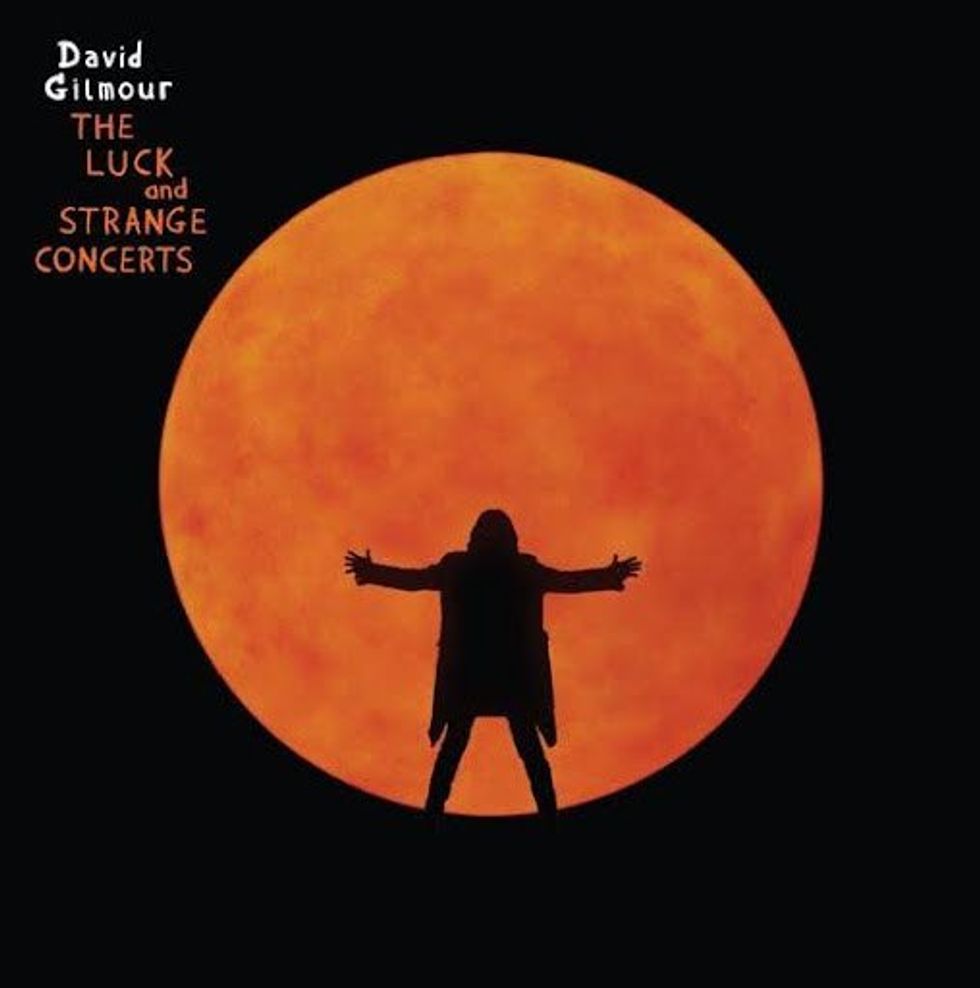
The tour accompanied Gilmour’s fifth solo album, LUCK AND STRANGE, which hit #1 in the UK, Germany (his first #1 there), Poland, Netherlands, Czech Republic, Switzerland, Portugal and Austria. It reached #2 in France, Italy, and Belgium, the top 5 in Spain, Japan, Norway, Denmark, and Hungary, and the top ten in the USA, Australia, Finland, Sweden, Ireland, and New Zealand.
The shows began with two sold-out warm-up shows at the Brighton Centre before moving to Circus Maximus in Rome for six sold-out nights, followed by the same at London's Royal Albert Hall before moving Stateside for sold-out evenings at the Intuit Dome and Hollywood Bowl in Los Angeles, before concluding with five sold-out nights at Madison Square Garden in New York.
All twenty-three dates were sold out, and with no new shows on the horizon, THE LUCK AND STRANGE CONCERTS and LIVE AT THE CIRCUS MAXIMUS, ROME is the best and only way to experience the master of his art on stage.
LIVE AT THE CIRCUS MAXIMUS, ROME, which is being released via Sony Music Vision and Trafalgar Releasing, will be shown in cinemas & IMAX worldwide on 17th September for a limited time only. The film sees Gilmour return to Rome's historic Circus Maximus at the beginning of the Luck and Strange tour, his first in nearly a decade. Long-time Gilmour collaborator Gavin Elder filmed the sublime spectacle against the backdrop of the ancient ruins of Rome. Tickets at cinemas around the world will go on sale 6th August at 2pm BST/ 9am EDT / 6am PDT. Full screening details for both IMAX and standard format cinemas will be available at davidgilmour.film. LIVE AT THE CIRCUS MAXIMUS will also be released on 2 Blu-Ray and 3 DVD sets with bonus unseen footage and the full THE LUCK AND STRANGE CONCERTS mixed in 5.1 and Atmos (Blu-Ray only) on 17th October.
THE LUCK AND STRANGE CONCERTS features 23 tracks across 4LPs or 2CDs recorded at selected shows from the tour and blends solo tracks from David’s most recent album, including a stirring rendition of Between Two Points with Romany Gilmour as well as classic Pink Floyd anthems such as Sorrow, High Hopes, Breathe (In The Air), Time, Wish You Were Here, and Comfortably Numb. The super deluxe edition of the album features all the formats as well as a 120-page hardback book, DAVID GILMOUR LUCK AND STRANGE LIVE, featuring Polly Samson’s photographs taken on the tour.
The audio for THE LUCK AND STRANGE CONCERTS and LIVE AT THE CIRCUS MAXIMUS, ROME has been co-produced by David and Charlie Andrew, who co-produced the Luck and Strange album.
For the lucky fans who experienced these once-in-a-lifetime shows, THE LUCK AND STRANGE CONCERTS and LIVE AT THE CIRCUS MAXIMUS are the perfect reminders of Gilmour’s soulful, expressive, and meticulously melodic guitar playing and the brilliance of his incredible band. For those who missed the shows, the album and the film offer a once-in-a-lifetime chance to experience this extraordinary musical event.
One-Stop Polished Acoustic Tone: L.R. Baggs Align Series Demo with Zach Wish
Zach Wish puts the L.R. Baggs Align Series pedals through their paces on his personal AEG-1 acoustic, demonstrating how each pedal brings studio‑quality effects to your DI signal. Hear the Session, Chorus, Delay, and Reverb in action and watch Zach dial in a pro-level tones from a compact package. Whether you want a simple, all‑in‑one acoustic board or individual pedals to suit your rig, the Align Series is ready to strum.
LR Baggs Align Session Acoustic Saturation/Compressor/EQ Pedal
Align Session Pedal
LR Baggs Align Chorus Acoustic Chorus Pedal
Align Chorus Pedal
LR Baggs Align Delay Acoustic Delay Pedal
Align Delay Pedal
LR Baggs Align Reverb Acoustic Reverb Pedal
Align Reverb Pedal
RhPf Electronics Unleashes Mosferatwo Mosfet Overdrive
RhPf Electronics has unveiled the Mosferatwo, a handcrafted MOSFET overdrive pedal designed for players who want to sculpt saturated tones with clarity, nuance, and punch.
Built around a 100% original circuit, it delivers everything from clean boost to greasy fuzz through a stack of carefully voiced gain stages and precision EQ shaping — all with the touch sensitivity and harmonic richness of a cranked tube amp.
- Dual-stage Drive control: One knob, two gain stages — for smooth transitions from subtle grit to snarling overdrive.
- Interactive Focus control: Shapes both dynamic feel and frequency response — bold and bloomy to tight and articulate.
Initially designed with gritty garage-blues duos in mind — where a single guitar needs to fill the entire sonic spectrum — Mosferatwo has since earned praise from a wide range of players for its amp-like response and bold, characterful voice. It’s already landed on boards across styles, from raw vintage blues to modern fuzzed-out riffing.
Like all RhPf Electronics creations, Mosferatwo is not a clone, mod, or tweak — it’s a fresh, fully original circuit built from the ground up.
Street price is $179. They’re available at select retailers and can also be purchased directly from the RhPf Electronics online store at rhpfelectronics.com.
Xvive announces H3 Transmitter Holder for the A58 and P58 GuitarWireless Systems
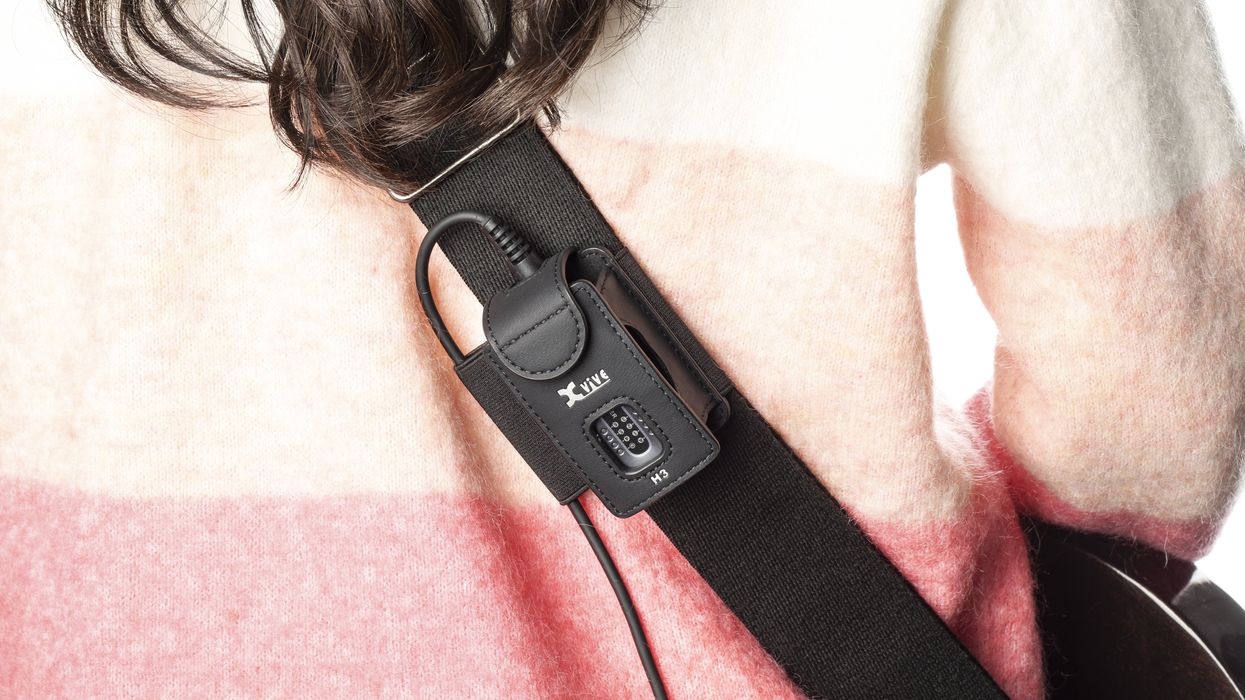
The Xvive H3 Transmitter Holder is specially designed for the Xvive A58 andP58 Guitar Wireless Systems.
It allows you to securely fasten the A58T Transmitter to your guitar strap, keeping it away from the instrument’s output jack to avoid interference from active electronics. This setup helps reduce high-frequency noise that can be caused by active circuits in electric guitars or basses. For acoustic guitars with integrated microphone pickup systems, the H3 also helps to eliminate wireless signal interference issues.
Constructed from durable leather and equipped with a secure hook-and-loop strap, the H3 ensures that your transmitter stays firmly in place during performances. It includes a ¼” TS male to ¼” TS female adapter cable to easily connect the transmitter to your instrument’s output jack. If your guitar or bass has a recessed or unusually placed output jack, the H3 adapts with ease. Its compact, lightweight design makes it ideal for stage, studio and home use.
H3 is available from Xvive dealers and online stores worldwide for $28.99 (USD MAP).
H3 product page: www.xvive.com/audio/product/h3-transmitter-holder
A58 product page: www.xvive.com/audio/product/a58-guitar-wireless-system/
P58 product page: www.xvive.com/audio/product/p58-guitar-wireless-system-with-tuner-pedal/
Fender Amp Primer: Deluxe Reverb and Princeton Reverb
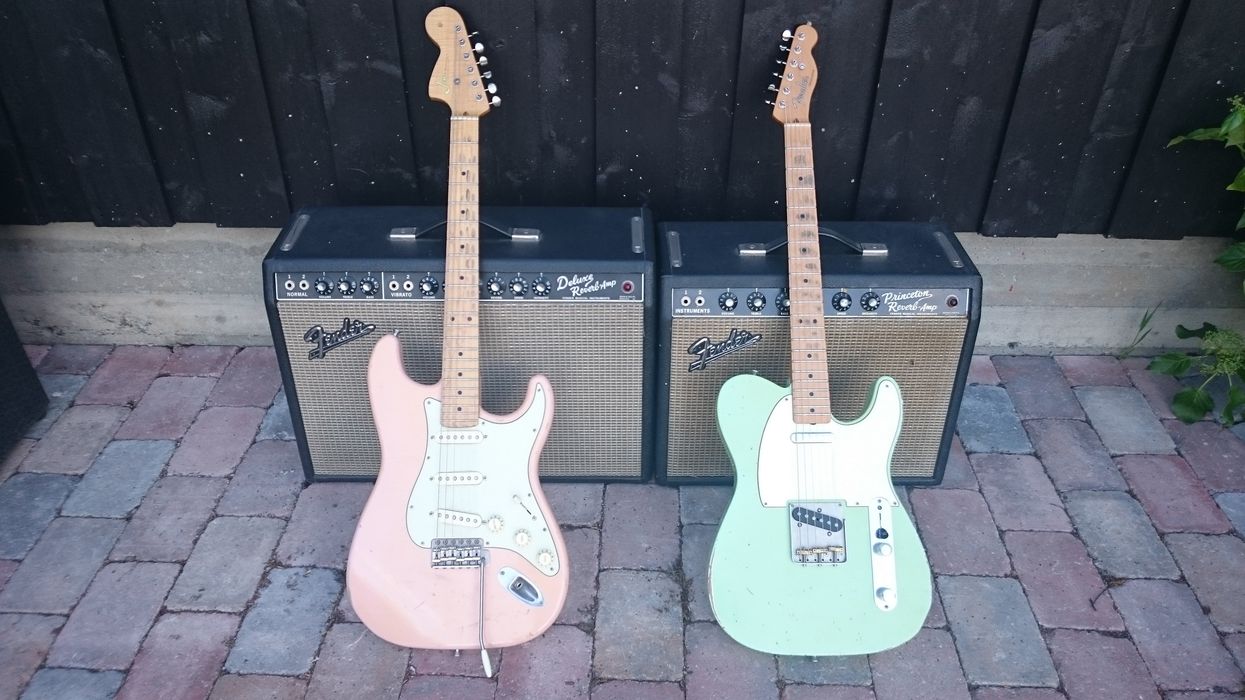
For those of you in the beginning of your Fender amp journey, there are myriad options and you might be uncertain where to start. I’ll introduce two of the most famous guitar amps on the planet: the Deluxe Reverb and the Princeton Reverb. (If you’re more experienced with Fender amps, see if you agree with my analysis of their qualities and differences.)
The Deluxe Reverb and Princeton Reverb amps were first introduced in Fender’s black-panel era (1964–1968). These amps are still made somewhat close to the originals; modern reissue models are available with either printed circuitboards or more exclusive point-to-point wiring, like their predecessors.
The strengths of both models lie in their simplicity, portability, and the much sought-after ability to break up at moderate volumes. Up to a certain point, they’ll deliver similar clean tones, characterized as the scooped Fender black-panel tone, intended to amplify the guitar as transparently as possible. Both are perfect amps for professionals and hobby players who want a stripped-down, reliable tube amp with only reverb and tremolo.
Both amps have dual 6V6 tubes in a push/pull class AB configuration, but their power amp sections are quite different. The Deluxe Reverb has a larger output transformer, a larger power transformer, higher 6V6 plate voltages, and the more efficient long-tail PI (phase inverter) circuit, versus the Princeton Reverb’s flabby-sounding cathodyne PI. The long-tail PI is widely used across 2-channel 6L6 Fender amps like the Vibrolux, Super, Twin, and Pro—the AB763 circuit amps.
The Deluxe produces 22 watts, and the Princeton a modest 12 to15 watts. Additionally, the Deluxe has a bigger speaker and a larger cabinet. The 1x10" Princeton Reverb is 16" tall, just under 20" wide, and 9 1/2" deep, weighing approximately 34 pounds. The 1x12" Deluxe Reverb is approximately 17 1/2" tall, 24 1/2" wide, and 9 1/2" deep, weighing approximately 42 pounds, and all this contributes to a louder and cleaner tone with more ambience and a bigger low end.
What does this mean? If you are looking for maximum portability and the earliest breakup, opt for the Princeton. In a recording or miked context, you won’t be bothered by its smaller, boxy tone. Plug in your Telecaster and you will be transported directly to Nashville. The Princeton Reverb can even be used with a single 6L6 tube in class A operation for ultra-low power (5 to 7 watts).
On the other hand, the Deluxe sounds slightly bigger on its own at home, in the practice room, and on stages where you need to cut through. It can even take 6L6 tubes for more power and clean headroom (about 30 watts). This 6L6 trick is not possible with the Princeton Reverb. However, the smaller Princeton is still quite capable if we do something with the speaker. It can be much louder if you swap a vintage speaker to a highly efficient modern speaker or, even better, disengage the built-in speaker and use a 1x15" extension cabinet. I love the combination of the Princeton’s early breakup through a big and full speaker cabinet loaded with a 15" Eminence Legend 1518. It’s huge and punchy, but not ear-breaking. Both amps require an 8-ohm speaker impedance, allowing a wide set of extension speakers in the range of 4 to 16 ohms.
The preamp sections of these amps are more similar, but with a few differences. The controls are the same: volume, treble, bass, reverb, tremolo intensity, and tremolo speed. Obviously, the Deluxe Reverb also has a second normal channel without reverb and tremolo. It also lacks the 47 pF bright cap, making it smoother and warmer than the vibrato channel, just like the single-channel Princeton Reverb, which also comes without this bright cap. This explains why many players think the Princeton handles pedals and bright guitars better than the Deluxe. Personally, I never use the normal channel of classic Fender amps other than sometimes routing my reverb return signal into it. That way, I can control the reverb with the normal channel’s volume and EQ knobs for more tonal options, like a dark and long reverb tone. I use a phono/jack adapter plug for this trick. Other than the bright cap, the tone stack is similar in these amps.
While the tremolo controls are the same on these amps, the tremolo circuits are built differently. The Princeton Reverb’s bias tremolo can get really deep, but only if you set the bias correctly, which can be a bit of a hurdle since it lacks an adjustable bias screw. If you struggle with weak tremolo, you can experiment with different 6V6 power tubes, rectifier tubes (either 5U4GB or GZ34, depending on the model), and 12AX7 tremolo/PI tubes (the one closest to the 6V6s). If that doesn’t help, the caps and resistors in the tremolo circuitry must be inspected. With the Deluxe Reverb’s AB763 optoisolator tremolo design, the sound is easier and more consistent.
I hope you are inspired to try out at least one of these legendary amps. I guarantee you will not be disappointed.





